NURSING
REIMAGING NURSING EDUCATION
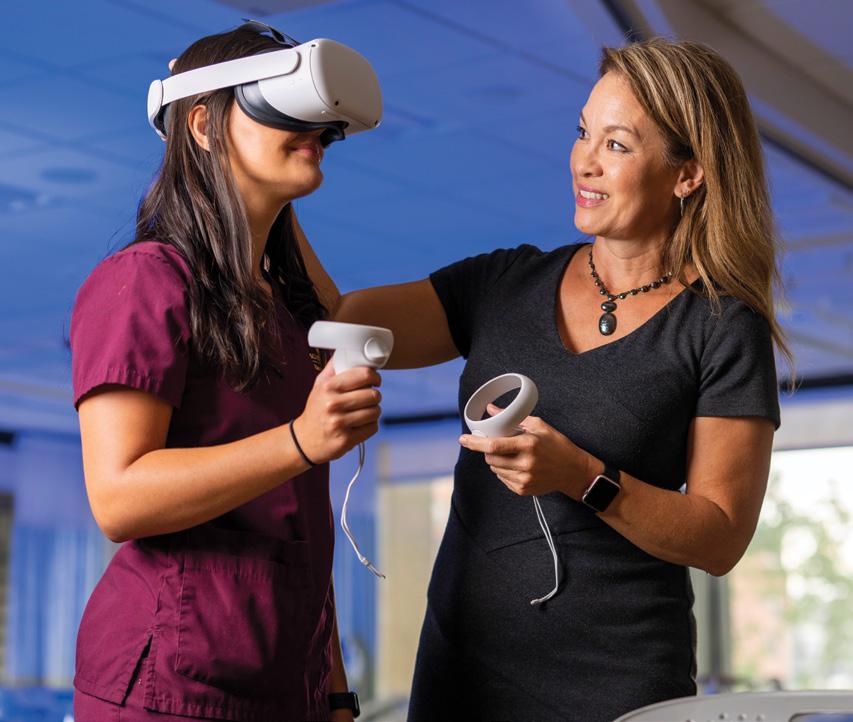
Bradley awarded $1.3
grant
24 Educating the next generation of doctorally prepared American Indian/Alaska native nurses 21 Minnesota nursing schools join together to address nursing workforce crisis 06 Nursing research at the Minnesota State Fair
Cynthia
million American Nurses Foundation
to pilot immersive virtual reality, structured clinical preceptorship
MINNESOTA A publication of the University of Minnesota School of Nursing FALL/WINTER 2022
Striving to increase equity in diet and weight-related health outcomes
Horning receives NIH funding to evaluate Twin Cities Mobile Market




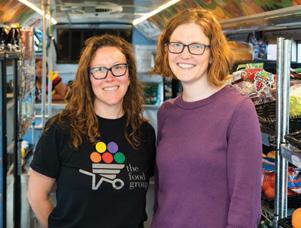
ON THE COVER
18 Reimaging nursing education

Cynthia Bradley awarded $1.3 million American Nurses Foundation grant to pilot immersive virtual reality, structured clinical preceptorship
40 Upward voyage
Ryan Marczynski returns to the Navy as an officer, with his BSN and a bevy of practical experience

46 Alum May Hang chairs first Hmong nurses association conference
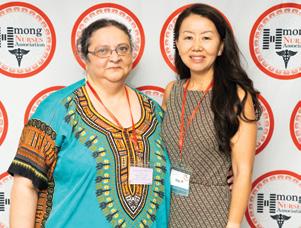
CTSI grant funds pilot study conducted in partnership with faculty
From the Dean
www.facebook.com/umnnursing www.twitter.com/umnnursing www.instagram.com/umnnursing www.linkedin.com/school/umnnursing www.youtube.com/user/umnnursing
Read Minnesota Nursing online at www.nursing.umn.edu/magazine
To receive a notice when the current issue is posted on the school’s website, send an email to nursenews@umn.edu.
This publication is available in alternative formats upon request. Direct requests to the managing editor at nursenews@umn.edu.
The University of Minnesota is committed to the policy that all persons shall have equal access to its programs, facilities, and employment without regard to race, color, creed, religion, national origin, sex, age, marital status, disability, public assistance, veteran status, or sexual orientation.
The University of Minnesota is an equal opportunity educator and employer.
2 | MINNESOTA NURSING 46 40 10 FALL/WINTER 2022
10
SECTIONS 04
06 Research 18 Education 35 Outreach 46 School News 70 Alumni News FOLLOW US
UNIVERSITY OF MINNESOTA SCHOOL OF NURSING
OUR VISION
Optimal health and wellbeing for all people and the planet.
OUR MISSION
To generate knowledge and educate leaders to shape the future of nursing and advance health care to improve the health and wellbeing of all.
DEAN Connie White Delaney, PhD, RN, FAAN, FACMI, FNAP
SENIOR EXECUTIVE ASSOCIATE DEAN FOR ACADEMIC PROGRAMS
Christine Mueller, PhD, RN, FAAN, FGSA
ASSOCIATE DEAN FOR RESEARCH
Diane Treat-Jacobson, PhD, RN, FAAN
COOPERATIVE CHAIRS
Donna Bliss, PhD, RN, FAAN, FGSA
Wendy Looman, PhD, APRN, CPNP-PC
Jenna Marquard, PhD
BOARD OF VISITORS
David Aanonson, pastor (ret.); Clara Adams-Ender chief nurse executive, Army Nurse Corp. (ret.); Cyrus Batheja, National Medicaid Vice President - Policy and Clinical Solutions UnitedHealthcare Community & State; Jeannine Bayard, United Health Group (ret.); Michael Bird, past president, American Public Health Association; Shonda Craft, dean, School of Health and Human Services, St. Cloud State University; Jessica Drecktrah, chief nursing officer, Faith Community Nurse Network; Melanie Dreher, dean emeritus, Rush University College of Nursing; Peter Klein, CEO, Educated Change; Rahul Koranne, CEO, Minnesota Hospital Association; Richard Norling, senior fellow, Institute for Healthcare Improvement; Laura Reed, chief nurse executive and COO, M Health Fairview; Jeannine Rivet, executive vice president, UnitedHealth Group (ret.); Michael Rohovsky, Associate Corporate Office of Science & Technology, Johnson & Johnson, (ret); Franklin Shaffer, president and chief executive officer, CGFNS; Jessica Sylvester, nursing executive and chief executive officer, Call Light Health; Dee Thibodeau, senior executive in information technology; Sylvia Trent-Adams, executive vice president and chief strategy officer, The University of North Texas Health Science Center; Charlotte Weaver, former senior vice president and chief clinical officer, Gentiva Home Health & Hospice; Cathleen Wheatley, president, Atrium Health Wake Forest Baptist Medical Center and senior vice president of clinical operations; and Jonathan M. Zenilman, chief, Infectious Diseases Division, Johns Hopkins Bayview Medical Center and professor at Johns Hopkins Bloomberg School of Public Health
DIRECTOR OF STRATEGIC COMMUNICATIONS
Steve Rudolph
SENIOR EDITOR Brett Stursa
PHOTOGRAPHERS
Darin Kamnetz, Tom Steffes, Scott Streble
DESIGNER Tammy Rose
CONTACT US
Minnesota Nursing University of Minnesota School of Nursing 5-140 Weaver-Densford Hall 308 Harvard Street S.E. Minneapolis, MN 55455
Email: nursenews@umn.edu Website: www.nursing.umn.edu
Minnesota Nursing is published semi-annually by the University of Minnesota School of Nursing for alumni, faculty, students and friends of the school.
©2022 Regents of the University of Minnesota. All rights reserved.
Celebrating students' entry into the profession
Ryannon K. Frederick, MS, RN, chief nursing officer, Mayo Clinic delivered the keynote at the Welcome to the Nursing Profession on Sept. 9 in Coffman Theater. The ceremony welcomes sophomores in the Bachelor of Science in Nursing program and first-year Master of Nursing students to the profession.

www.nursing.umn.edu | 3
Photo: Darin Kamnetz
FROM THE DEAN
Reimagining the future of nursing
Dear Friends,
At the School of Nursing’s spring commencement, I shared with the Class of 2022 how despite the challenges they had faced as students and might see our profession facing at this moment, I had never been more optimistic about the future of our school and nursing’s potential to positively impact the health and wellbeing of our communities and the planet. Reading this issue of Minnesota Nursing affirms some examples of the “why.”
As the cover denotes, this issue highlights some of the ways the school is reimagining the future of nursing. We all know that continuing to do what we’ve been doing won’t address the current nursing shortage or the even greater one our state, and all of us, are facing in the very near future.
Consequently, that is why we are proud to help launch the Coalition for Nursing Equity and Excellence. Anchored in collaboration, the coalition will provide the holistic approach to workforce and equity the Minnesota’s health care system so urgently needs.
One way we might partner and share resources for the betterment of all is outlined in the story about the American Nurses Foundation grant to pilot immersive virtual reality. In addition, our Partnering for Health feature shares how the school’s academic-practice partnership with M Health Fairview is addressing the nursing faculty shortage, particularly in Advanced Practice Registered Nurse specialties. The collaboration is providing clinicians an opportunity to both advance their career and gain experience as an educator, and the school welcomes
feedback on health systems expectations for new graduating nurses. The new Health Resources and Services Administration grant will increase the number of doctorally prepared American Indian/ Alaska Native nurses.
Our nurse scientists are uniquely meeting the community where they are to advance health. By conducting research at the Minnesota State Fair, our scientists are reaching a diverse pool of participants and receiving valuable feedback from the public. The two stories that follow detail recent NIH grants through which the school’s faculty are addressing health inequities.
Turning our attention globally, we celebrate the University of Minnesota’s 40 year partnership with the University of Iceland, a relationship that has included research collaboration and student/ faculty exchange and continues to deepen with each year. And we share the story of PhD candidate Charles Osingada who is studying the potential of telehealth to enhance HIV care in Uganda, one of our global partners.
We welcome our increased connection with you. We welcome your reflections, suggestions and shared wisdom. We are grateful for your unwavering interest and engagement.

In gratitude, Connie White Delaney Professor and Dean

4 | MINNESOTA NURSING
School partners with M Health Fairview for adjunct clinical faculty
by Brett Stursa
When the School of Nursing had a need for faculty, particularly in Advanced Practice Registered Nurse specialties, it didn’t have to look far for a partner. M Health Fairview, which the school has an academic-practice partnership with, was enthusiastic to collaborate.

“It is a win — win for both M Health Fairview and the School of Nursing,” says Linda Wick, MS, associate chief nurse executive at M Health Fairview.
“The clinicians have an opportunity to advance their career and gain experience as an educator. Working in an academic environment pushes our clinicians to stay current on best practice and the latest research in nursing care, as well as strengthens the relationship with the School of Nursing.
In addition, M Health Fairview clinicians have opportunity to identify high performing students and can help recruit these students to be future employees
PARTNERING FOR HEALTH
of M Health Fairview. The school will get faculty that are active clinicians and can help to educate students based on both theoretical foundations and practice experience. The students will also have a connection into M Health Fairview for their clinical experience.”
The school first began utilizing adjunct clinical faculty with the nurse-midwifery specialty through an agreement with University of Minnesota Physicians. Later, two practicing nurse anesthetists joined the school as adjunct clinical faculty. As the school’s need for faculty in the family nurse practitioner and psychiatric/mental health nurse practitioner specialties grew, the school reached out to Wick and Laura Reed, DNP, RN, executive vice president, chief nursing executive, and chief operating officer.
“We proposed this potential strategy with nurse practitioners. They were completely supportive and just opened
the door and said, ‘absolutely,’” says Christine Mueller, PhD, RN, FGSA, FAAN, senior executive associate dean for academic programs.
Both Mueller and Wick say this collaboration is another opportunity for the school to receive feedback on what health systems expectations are for new graduating nurses.
“New nurses will be taking care of higher acuity patients than they did in the past, and the health system and School of Nursing are collaborating on how to best prepare these nurses,” says Wick.
PARTNERING FOR HEALTH is a recurring feature that highlights a school partnership working to advance health care to improve the health and wellbeing of all.
www.nursing.umn.edu | 5
Adjunct Clinical Assistant Professor Megan Kakela, DNP, APRN, CRNA, and Adjunct Clinical Assistant Professor Julie LaRose, DNP, APRN, CNP.
DNP student Emily Moccio assists a child completing a survey for the research project Resilience Portfolios in Youth: A Novel Measure of Protective Factors for Wellbeing at the Minnesota State Fair in August.

RESEARCH
NURSING RESEARCH AT THE FAIR
High energy atmosphere provides a fun backdrop for research ranging from child resiliency to COVID-19 and heart health
by Brett Stursa
When Professor Wendy Looman, PhD, APRN, CPNP-PC, first began conducting research in the Driven to Discover Research Facility at the Minnesota State Fair, she noticed that even before the building opened people were waiting to get in.
“I looked out and there are all these people waiting to get in,” says Looman. “I used to think you had to beg and cajole people to participate in research. But when they open the door, people come rushing in.”
The Driven to Discover Research Facility was launched in 2014 to bring University research and researchers into closer contact with the Minnesota community.
Nearly 2 million people visit the fair each year from across the state, which allows researchers to reach a diverse pool of participants and the opportunity to meet
recruitment goals. At the same time, it gives fairgoers a better understanding of the research being conducted at the University and gives them a chance to participate in it.
“It just changed my perspective on how people in the community want to be engaged in research," says Looman, who is researching kids’ resiliency. “Kids are willing to put down their corn dogs and get off the rides and sit down with a research team member and talk with us about their life. What they share is deep and insightful. It makes research accessible to the public and to students in a way that you really can’t get in a lab.”
This year, nurse researchers from the School of Nursing conducted projects ranging from child resiliency and long-term COVID-19 symptoms to mobile health applications, heart attack and stroke prevention, and adult's perception of primary health care.
“These projects are an example of the different kinds of research being done in just a small cross section of the University,” says Associate Professor Mary Fran
on
Photo: Darin Kamnetz

www.nursing.umn.edu | 7
continued
page 8
continued from page 7
Tracy, PhD, RN, who conducted research on the physical, emotional and mental health symptoms people experience after having had COVID-19 and whether those symptoms continue. “All the researchers are happy to be present and you see the excitement and engagement of the University students who are participating in the conduct of research as well.”
INVOLVING STUDENTS IN RESEARCH
Nursing students often serve on research teams at the fair, providing them a firsthand look at what it’s like to conduct research.
“It’s an opportunity for students to be involved in a research study that is fun and low key,” says Looman. “In our project, students are collecting the data that they use for their honors thesis. So there is a real connection to the research experience that they wouldn’t have if they just used a data set that I collected.”
This year, 13 Master of Nursing students volunteered to consent participants, perform the measures and provide education on cardiovascular disease risk for Associate Professor Erica Schorr’s

study Protect Against Heart Attack and Stroke: Know Your Numbers to Control Your Risk.
“I think state fair projects are ideal for getting students involved and interested in research,” says Schorr, PhD, BSBA, RN, FAHA, who adds that it was also a great opportunity for Sam Theesfeld, a new PhD student, to get experience as a co-PI on a research project.
8 | MINNESOTA NURSING
Research team members Elena Geiger-Simpson, Khadra Mohamed, Emily Moccio, Wendy Looman and Adrianna Bell.
• • •
“Kids are willing to put down their corn dogs and get off the rides and sit down with a research team member and talk with us about their life. What they share is deep and insightful. It makes research accessible to the public and to students in a way that you really can’t get in a lab.”
– Wendy Looman, who has conducted research at the fair for four years
PhD student Sam Theesfeld and Associate Professor Erica Schorr at the Driven to Discover Research Facility.
COMMUNITY PARTICIPATION IN RESEARCH
Research at the state fair provides fairgoers the chance to participate in research in an innovative way. For Schorr’s study, participants liked learning about how they can make simple changes to reduce their risk of heart attack and stroke. “And, of course, they love the prize wheel,” says Schorr, who created the prize wheel for participants to spin and get a chance to win a watch that monitors heart rate, physical activity and sleep.
“It’s a fun, high energy place,” says Schorr. “It’s not a quiet, sterile building that some people may envision when they hear the phrase research study.”
Being situated in the middle of the fairgrounds also makes it convenient for participants. More than 750 kids have participated in Looman’s study over three years, a number that she would
have a difficult time reaching at a lab on campus. “I think the kids feel important,” says Looman. “They get to participate in science and parents appreciate that their kids get to know the university and be part of research.”
She credits Logan Spector, PhD, and Ellen Demerath, PhD, Driven to Discover Research Facility directors along with manager Annie Hotop, for creating a successful research atmosphere at the fair.
Assistant Professor Robin Austin, PhD, DNP, DC, RN-BC, FAMIA, FNAP, who conducted research related to the use of mobile health applications, appreciates the opportunity to bring her work to the public and receive input from the community. “I think it is a great way to be a part of our land grant mission of our University and bring research and work we are doing at the School of Nursing to those in the community,” says Austin.
AT THE FAIR
These nurse researchers led studies at the Minnesota State Fair this year.
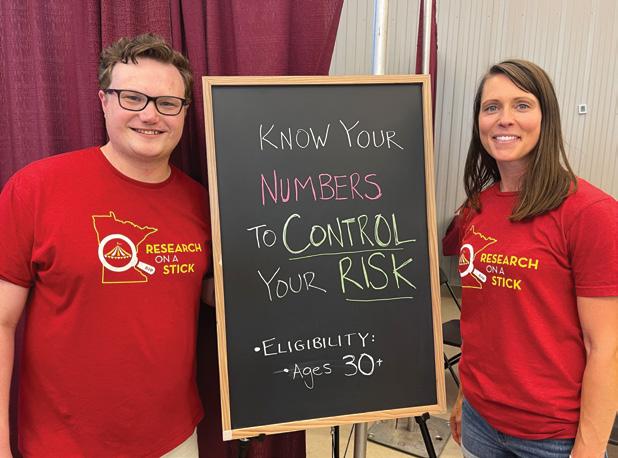
Mary Benbenek Patients Engaged! Exploring Patient Perspectives to Transform Primary Care
Wendy Looman Resilience Portfolios in Youth: A Novel Measure of Protective Factors for Wellbeing
Mary Fran Tracy The Emotional, Mental Health, and Physical Symptom Experience of Adults
Following COVID-19 Infection
Erica Schorr Protect Against Heart Attack & Stroke: Know Your Numbers to Control Your Risk!
Robin Austin Examining Consumer Use and Knowledge of Data Sharing Practices within Mobile Health Applications
Casey Hooke How Does Your Child Mooove?
www.nursing.umn.edu | 9
Twin Cities Mobile Market Program Manager
Stephanie Wagner and Associate Professor Melissa Horning in a Twin Cities Mobile Market, which sells quality groceries from a repurposed city bus.
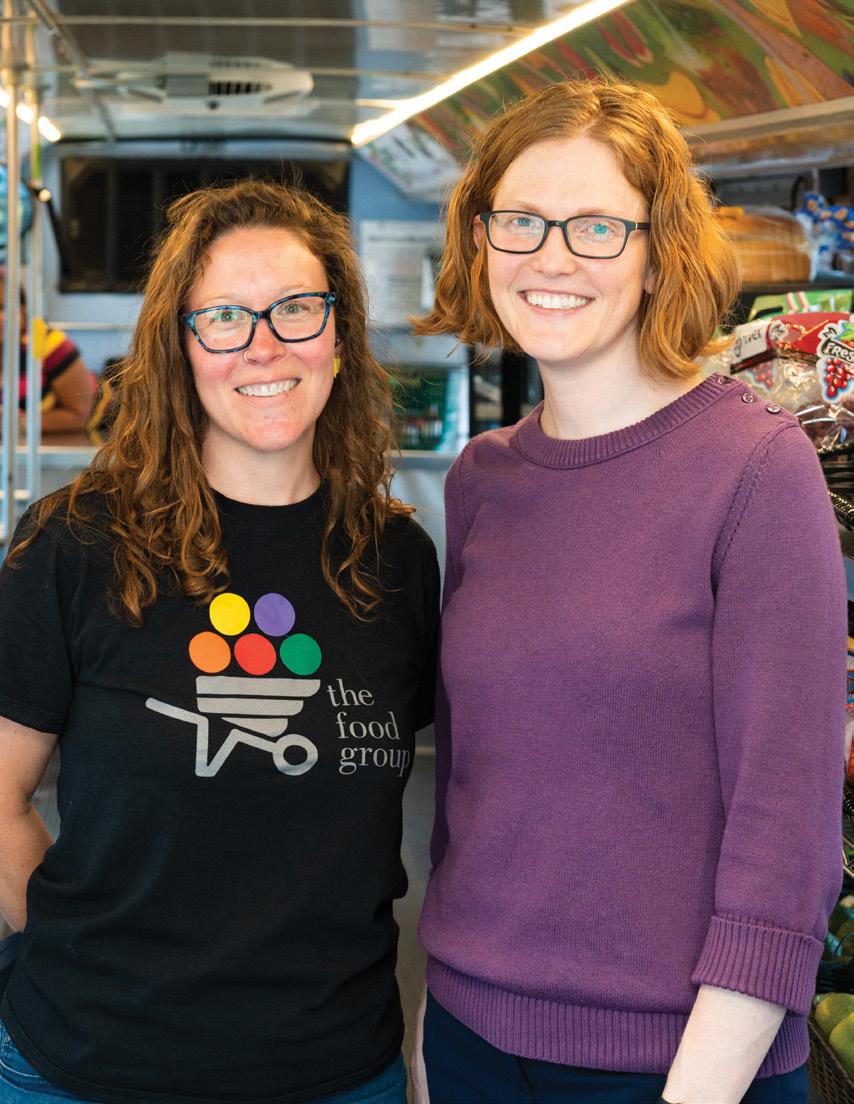
STRIVING TO INCREASE EQUITY IN DIET AND WEIGHT-RELATED HEALTH OUTCOMES
Horning receives NIH funding to evaluate Twin Cities Mobile Market
by Brett Stursa
Associate Professor Melissa Horning’s research seeks to increase equity in diet and weight-related health outcomes by improving access to and intake of healthy foods.
“Individuals who have racial and ethnic minoritized identities and those who experience low incomes are disproportionately impacted by poor nutrition and related health outcomes such as type 2 diabetes and high blood pressure,” says Horning, PhD, RN, PHN. “Lack of affordable, healthy food access and food insecurity are believed to be important contributing factors to these inequities.”
Increasingly mobile food markets are being utilized to address these inequities because they bring low-cost, healthy food directly to underserved populations. “There is growing evidence that mobile produce markets may increase fruit and vegetable intake, but there is little research on full-service mobile markets that can holistically meet people’s food needs or whether mobile market shopping improves food insecurity,” says Horning.
Twin Cities Mobile Market sells quality groceries from a repurposed city bus that regularly visits low-income community sites. The shelves are stocked in ways that nudge shoppers toward healthier purchases. Foods are sold at prices
Darin Kamnetz
approximately 10% below those of grocery stores and include foods from all food groups and pantry staples. SNAP/ EBT is accepted, and a state-funded fruit/ vegetable incentive program, Market Bucks, is available to shoppers.
Horning and her community partners at the Twin Cities Mobile Market were recently awarded a National Institutes of Health grant for Evaluating Diet, Food Insecurity, and Food Purchasing Outcomes of a Full-Service Mobile Food Market with a Cluster Randomized Trial. The project is assessing the impact of the full-service Twin Cities Mobile Market in underserved communities. “What this grant allows us to do is to know whether a full-service mobile market shifts the quality of the foods that people eat and buy and improves their level of food security. We will also explore what factors allow and encourage community members to use the Mobile Market,” says Horning.
The cluster randomized trial will involve 12 community sites in three waves that will either receive Mobile Market service right away after baseline data collection or after about one year. Across these community sites, Horning is aiming to have 264 people take part in study activities. The primary trial goals are to compare baseline to follow-up changes in diet quality (using 24-hour dietary recalls), fruit and vegetable purchases (by collecting one month of fruit and vegetable purchase data), and level of food insecurity between the sites that
receive mobile market service and those that don’t during this period.
“Findings will provide evidence on the effectiveness of a full-service mobile market to improve diet, food security and food purchasing habits,” says Horning.
“As policy makers aim to address food insecurity that the pandemic placed into the spotlight and support innovative food programs that have demonstrated positive impact on communities, this research will provide timely evidence to inform policy and legislative decisions.”
WORKING IN PARTNERSHIP TO FIND SOLUTIONS TO FOOD INEQUALITY, ACCESS
As Horning develops her research program, she knows she wants to continue to work in partnership with the community, leveraging her research skills to support and invigorate the work they do every day. A conversation over coffee in 2016 about mobile markets led to collaborating with the Twin Cities Mobile Market. “This research started from a place of mutual respect and trust, so it’s been a really natural partnership,” says Horning.
No matter the findings of this grant, Horning is committed to a research trajectory that includes community partnerships. “The goal, long term, is to work in partnership with community to develop and support solutions that address food insecurity and food access in our communities,” says Horning.
www.nursing.umn.edu
| 11
Photo:
NEW RESEARCH SEEKS TO REDUCE THE SUMMER HEALTH GAP
Lee awarded NIH grant to evaluate Summer Food Service Program
by Brett Stursa
Assistant Professor Jiwoo Lee, PhD, RN, LSN, is leading the evaluation of public health nutrition programs to guide future development of childhood obesity prevention interventions designed to reduce weight-related disparities.
Lee was awarded a National Institutes of Health K23 award for Reducing the summer health gap: Evaluation of community-based child nutrition assistance program “We all know healthy eating is important for children’s growth and development,” says Lee. “When children develop healthy eating habits at a young age, those habits are more likely to be carried forward into adulthood.”
Lee’s research is evaluating the Summer Food Service Program (SFSP), a communitybased child nutrition assistance program funded by the United States Department of Agriculture. This program addresses the nutritional gap of increased food insecurity that low-income children experience during
the summer months by providing meals to children at program sites, like parks and community centers.
Lee is conducting a prospective observational study to describe program site and participant characteristics. This study will evaluate the current program implementation and determine if the site and participant characteristics are associated with child program attendance and changes in food insecurity, diet quality and weight gain.
Two cohorts of elementary school-aged children and their parents, for a total of 210 families, will participate in data collection before and in the final weeks of the program. They will be recruited through SFSP sites in the Twin Cities. Data collection components include an online psychosocial survey, three 24-hour dietary recalls, and measurement of height, weight and percent body fat. Additionally, parents will report program usage weekly during the program.
“I’m hoping that we can identify important characteristics of the Summer Food Service Program that drive children’s program usage,” says Lee. “Additionally, the study will help us better understand if and how the program participation contributes to children’s nutritional health.”
HEALTH EQUITY, COLLABORATIONS WITH COMMUNITY PARTNERS
The K23 award also includes protected time for career development. A multidisciplinary team of mentors at the University of Minnesota will guide the project and career development activities in areas of health equity approaches in reducing food insecurity and weight gain, advanced statistical skills for use in evaluation of the long-term impacts of public health programs, implementation science and intervention development, and collaborations with community partners. Mentors include School of Nursing’s Jayne Fulkerson, PhD, and School of Public Health’s Lisa Harnack, DrPH, RD, MPH, Weihua Guan, PhD, and Nancy Sherwood, PhD.
“As an early-career investigator, I’m deeply thankful for this support in being an independent researcher under mentor guidance,” says Lee. “There are many layers to consider when conducting a community-based research study. My mentors’ diverse expertise and insight will help me grow as a researcher and advocate for children and their families’ health needs through rigorous scientific discovery.”
Photo: Darin Kamnetz
12 | MINNESOTA NURSING
Assistant Professor Jiwoo Lee's new research will identify characteristics of the Summer Food Service Program that drive usage.

Clinical Associate Professor Huong Nguyen is both a researcher and Buddhist nun. “When you see yourself clearly, then you can see other people as well. You see the root cause of the suffering and then you see the way out as well. So I stay in the temple for personal reasons and for research at the same time,” she says.

14 | MINNESOTA NURSING
BALANCING LIFE AS A RESEARCHER, BUDDHIST NUN
Huong Nguyen’s multi-site research spans the United States, Thailand and Vietnam
by Brett Stursa
As a clinical associate professor at the School of Nursing, Huong Nguyen’s research focuses on reducing family caregiver stress and understanding the root cause of mental health disorders in order to develop an innovative therapy to treat them.
As a practicing Buddhist nun, Nguyen, PhD, MSW, MA, is also devoting her life to seeing her mind and body clearly.
“When you see yourself clearly, then you can see other people as well. You see the root cause of the suffering and then you see the way out as well,” says Nguyen. “So I stay in the temple for personal reasons and for research at the same time.”
Nguyen was born and raised in Vietnam, earning a bachelor’s degree in foreign trade economics from Hanoi Foreign Trade University. She later earned a master’s degree in mass communications from the University of Nebraska and a master’s degree and PhD in social work from the University of Chicago.
“I became the first person in post-war Vietnam with a PhD in social work,” says Nguyen. “To this day, the entire country still only has two or three people with PhDs in social work, so I am working with the Vietnamese government and different universities to train the very first generation of social workers, faculty and students, in Vietnam.”
Before coming to the University of Minnesota, Nguyen served as faculty in social work and religious studies at the University of South Carolina. There, she conducted multi-site research spanning the United States, Thailand
and Vietnam, including areas of spirituality and religion in mental health, Buddhism-based psychosocial interventions in mental health, elder care, supporting family caregivers of elderly people with dementia and Buddhist social work. She has conducted ethnographic research at Buddhist temples in Vietnam and Thailand, and is currently working with caregivers of individuals with dementia in Vietnam.
Nguyen is serving as co-PI for the National Institutes of Health-funded research Advancing Alzheimer’s family caregiving interventions and research capacity in Vietnam, being conducted with Ladson Hinton, MD, professor and director of Geriatric Psychiatry at University of California at Davis.
The project is testing the efficacy of Resources for Enhancing Alzheimer’s Caregiver Health in Vietnam (REACH VN), a culturally adapted family caregiver intervention shown in a pilot study to be feasible and promising in terms of preliminary efficacy. It is the first large-scale study to test the efficacy of a communitybased family dementia caregiver intervention in Vietnam. Results from this study will inform efforts to widely deliver the REACH VN intervention or similar community-based family dementia caregiver support programs in Vietnam and other low- and middle-income countries.
“The aim of this research in Vietnam is supporting family caregivers to reduce stress and burden,” says Nguyen. “In Thailand, the aim of my research is to develop a new therapy that would treat mental health disorders at the root. The real goal of all my work is to make people happy, but to make people happy we have to really understand the root cause of happiness.”
www.nursing.umn.edu | 15
AJPH SPECIAL ISSUE HIGHLIGHTS FACULTY’S PUBLIC HEALTH NURSING EXPERTISE
Monsen served as guest editor
by Brett Stursa
The American Journal of Public Health (AJPH) recently published the special issue The American Public Health Nursing After COVID-19: Strengthening, Rebuilding, and Reimagining the System. Several University of Minnesota School of Nursing faculty were contributing experts.

Professor Emeritus Karen Monsen, PhD, RN, FAMIA, FNAP, FAAN, served as a guest editor with Linda McCauley, dean of Emory University Nell Hodgson Woodruff School of Nursing, and Catherine Waters, Sally Bates professor and associate dean for academic affairs, University of California San Francisco School of Nursing. The supplement issue of AJPH, published in June, covers nursing and public health, offering insight into the importance of nurses during the COVID-19 pandemic as well as the future of nursing. Papers engage nursing and its intersection with climate change, vaccine readiness, community resilience and home visiting.
Articles written by School of Nursing faculty include:
• Nursing and Public Health Special Issue by Karen Monsen
• Public Health Nurses: The Most Essential Single Factor by Karen Monsen
• Trust, Translation, and Transparency in Public Health Nurse Family Home Visiting by Karen Monsen
• The Public Health Crisis Is Planetary—and Nursing Is Crucial to Addressing It by Teddie Potter
• Addressing the Critical Need for Timely Solutions for Improved Food Access and Food Security by Melissa Horning
• A Community-Based Participatory Intervention in the United States Using Data to Shift the Community Narrative From Deficits to Strengths by Robin Austin and Sripriya Rajamani
• Public Health Nurse Tailored Home Visiting and Parenting Behavior for Families at Risk for Referral to Child Welfare Services, Colorado: 2018–2019 by Robin Austin and Karen Monsen
External funding for the special issue was provided by leading public health nursing programs, including University of Minnesota School of Nursing, Johns Hopkins School of Nursing, Emory University Nell Hodgson Woodruff School of Nursing, University of WisconsinMadison School of Nursing, University of California San Francisco School of Nursing, and the University of Texas Austin School of Nursing.
16 | MINNESOTA NURSING
Structured for your success
Want to transform your career and the health care system but don’t have the tools to do so?
Become a full-practice provider and an innovative systems leader with a Doctor of Nursing Practice (DNP) degree from the University of Minnesota.
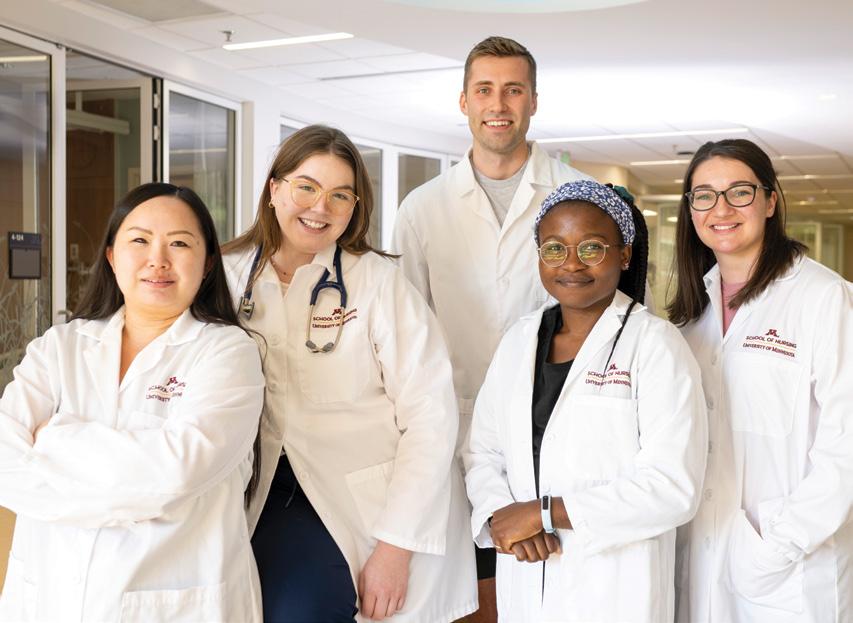
• Co-created learning experiences in one of 12 specialties
• Hybrid-by-design program that maximizes education with flexibility
• Worry-free and relevant practicum placements with trusted preceptors
• Strong support from faculty advisers, professional academic staff and our alumni network
Learn more and apply at z.umn.edu/DNP
www.nursing.umn.edu | 17

EDUCATION
BSN student Maura Talwalkar practices using an Oculus headset and controllers.
REIMAGING NURSING EDUCATION
 by Steve Rudolph
by Steve Rudolph
What more can be done to better prepare nursing students for practice?
Are there strategies a nursing school can implement to reduce the time their graduates need to onboard in the workplace? Can adding experiences in nursing curricula prevent burnout and turnover in nursing?
These are some of the questions Assistant Professor Cynthia Bradley, PhD, RN, CNE, CHSE, wrestles with as director of simulation at the School of Nursing. She’s hoping a three-year pilot that uses immersive virtual reality (VR) simulation coordinated with a structured clinical preceptorship and reflective debriefing will provide some of the answers.
Bradley is leading the Big 10 Practice-Ready Nursing Initiative, a partnership with the University of Michigan
School of Nursing and Purdue University School of Nursing. Bradley was awarded a $1.3 million grant from the American Nurses Foundation Reimagining Nursing Initiative. The project was one of 10 bold ideas, selected from more than 350 nurse-led projects under consideration to transform the education, regulation and practice of nursing.
The research team is collaborating with Oxford Medical Simulation, a global leader in the VR industry, to develop
five learning modules that will be used with an Oculus headset. Two modules have already been developed with three additional modules to be added in the spring.
BETTER PREPARING NURSING STUDENTS FOR THE WORKFORCE
A key component the researchers hope VR will add to nursing education is better preparation for students in caring for multiple patients, which more realistically represents current nursing practice. Two patients are typically the most a student nurse will care for during their education, yet early in their professional careers nurses are expected to care for a full caseload of patients. Adding more patients for students in their clinical experiences is not always feasible. Moreover, challenges with adequate space, expensive manikins and availability of standardized patients makes it nearly impossible to do multiple patient scenarios in simulation centers, which are already stretched to capacity.
“As a caseload of patients increases, how do students learn how to prioritize care? How do they know what to do first and with which patient?” asks Bradley. “We believe that in the virtual environment the student will be able to practice and master those skills, starting with one or two patients and increasing to a caseload of five. They’ll have more time to practice in a safe space without
Photo: Scott Streble
www.nursing.umn.edu | 19
Cynthia Bradley awarded $1.3 million American Nurses Foundation grant to pilot immersive virtual reality, structured clinical preceptorship
continued on page 20
continued from page 19
risking patient safety, while also gaining confidence and competence. Most importantly, they’ll be able to practice decision-making skills.”
To evaluate effectiveness of the pilot, the team will use a clinical competency tool to assess how students navigate the virtual environment as well as in the clinical environment at several time points during the first two years of the study. Bradley is recruiting two additional Big 10 schools to test if the VR learning process can be replicated in other nursing programs during the third year of the project.
EXPANDING ACCESS TO QUALITY SIMULATION
Throughout her career, Bradley has consulted with nursing schools on the use of simulation. In that time she has seen many programs that have the funding to buy manikins but not funding for training faculty to integrate manikin use into curricula or the training necessary to properly facilitate simulation debriefings.
“Simulation is a pedagogy that you have to understand, not to mention learning the art of leading a reflective debriefing, to give students active learning experiences that ultimately better prepare them to provide high quality patient care,” says Bradley. “It takes time and money to do this well, and faculty are already overburdened. One of the aims of this project is to do a cost analysis of VR simulation compared to traditional simulation.”
Assistant Professor Cynthia Bradley
The Big 10 Practice-Ready Nursing Initiative aims to develop a process that can be shared with others to improve clinical education, while also providing greater access and availability that may cost less than traditional simulation. Bradley hopes the toolkit can help nurse educators facilitate the highest quality learning experiences for nursing students in rural areas who may not have access to simulation centers.
“With a headset and an internet connection, students anywhere can have the same learning experiences as students in our program,” adds Bradley.
20 | MINNESOTA NURSING
• • •
“ As a caseload of patients increases, how do students learn how to prioritize care? How do they know what to do first and with which patient? We believe that in the virtual environment the student will be able to practice and master those skills, starting with one or two patients and working their way up to a caseload of five.”
–
MINNESOTA NURSING
SCHOOLS JOIN TOGETHER TO ADDRESS NURSING WORKFORCE CRISIS
Minnesota State, University of Minnesota announce newly formed Coalition for Nursing Equity and Excellence
by Steve Rudolph
Minnesota State and the University of Minnesota have entered into a collaboration to reimagine nursing education and address the growing shortage of nurses in Minnesota.
The newly formed Coalition for Nursing Equity and Excellence (CNEE) will work with every school of nursing in the state, health care providers and others invested in improving health care in Minnesota to increase enrollment in nurse education programs at all degree levels, expand equity in the nursing workforce and increase the success of nursing students.
“Continuing to do what we’ve been doing won’t address the current nursing shortage or the even greater one our state is facing in the very near future,” says Connie White Delaney, PhD, RN, FAAN, FACMI, FNAP, dean of the University of Minnesota School of Nursing. “There simply aren’t enough clinical training opportunities, nursing faculty and simulation capabilities to increase nursing enrollment and there aren’t currently enough qualified students. This Coalition for Nursing Equity and Excellence, anchored in collaboration, can provide the holistic approach Minnesota’s health care system so urgently needs.”
The need to address the shortage of nurses in Minnesota is urgent. Based on pre-pandemic data predictions, in 2025 Minnesota will need 23,000 new registered nurses (RNs) and 5,600 new licensed practical nurses (LPNs) due to regular climbing annual deficit. The pandemic has exacerbated this issue. Despite the increased demand for nurses at all levels, applications to some of the state’s nursing programs have been declining and some are forced to limit enrollment due to the inability to hire faculty.
“The need for additional nurses in Minnesota’s workforce is undeniable – in all regions of the state and at every level of the nursing career pathway,” says Valerie DeFor, MHSA, executive director of the Minnesota State HealthForce Center of Excellence. “Our collaboration with the University of Minnesota School of Nursing to create a platform for all nursing schools in the state will foster collaboration and focus resources on this critical need.”
COALITION TO FOCUS ON INEQUITIES IN THE NURSING PATHWAY
A major focus of the coalition will be on removing barriers to nursing education that have left the profession far less diverse than the communities it serves. The Minnesota Board of Nursing reports the nursing workforce in Minnesota has 13.5% non-white RNs and 15.7% non-white LPNs, compared to the general
www.nursing.umn.edu | 21
continued on page 22
continued from page 21
population that was approximately 21.8% non-white, according to the 2019 census data. In Minnesota’s nursing workforce, 9.8% of RNs identify as male and 6.8% of LPNs identify as male.
SCOPE OF CHALLENGE REQUIRES
TRUE STATEWIDE SOLUTION
Minnesota State and the University of Minnesota, as Minnesota’s leading public higher education systems with campuses across the state and programs encompassing the complete breadth of nursing education, are uniquely prepared to lead the CNEE’s mission in full collaboration with private sector nursing education programs.
“This collaboration is a natural fit that focuses the tremendous strength of Minnesota’s two systems of public higher education on a pressing need of the state,” says Devinder Malhotra, PhD, chancellor of Minnesota State. “We are very pleased to be working with the University of Minnesota School of Nursing and look forward to implementing new and innovative ways to build the health care workforce pipeline in Minnesota.”
“The University’s mission and its strategic plan, MPact 2025, aim to serve the state and impact the world,” says
University of Minnesota President Joan Gabel, JD. “This unique collaboration with Minnesota State is directly aligned with those objectives and, through this innovative coalition, we are reimagining nursing education to serve as a model in addressing one of the greatest challenges facing health care, in our state and our nation.”
Minnesota State and the University of Minnesota have partnered previously on nursing issues. Delaney is a member of the Minnesota State HealthForce Center of Excellence Partnership Council, which consists of leaders from the health care industry, educational institutions, industry associations and government, and meets quarterly to identify and address a broad spectrum of health care workforce challenges. Last year, a supportive pathway for students currently enrolled at Saint Paul College to transfer to the University of Minnesota School of Nursing to pursue a baccalaureate of science in nursing (BSN) degree was launched to help create a more diverse nursing workforce. The University of Minnesota has also partnered with St. Cloud State University to improve access to primary care in Central Minnesota.
“This collaboration is a natural next-step in our relationship,” says DeFor.
22 | MINNESOTA NURSING
• • •
“
Continuing to do what we’ve been doing won’t address the current nursing shortage or the even greater one our state is facing in the very near future.”
– Dean Connie White Delaney
AACN ESSENTIALS CALL FOR TRANSFORMING NURSING CURRICULUM
New curricular framework uses competency-based approach
by Brett Stursa
Faculty are leading an effort at the School of Nursing to transform baccalaureate, master’s, and Doctor of Nursing Practice curricula to reflect the new American Association of Colleges of Nursing (AACN) The Essentials: Core Competencies for Professional Nursing Education. The new model and framework for nursing education uses a competency-based approach. The Essentials introduces 10 domains and the expected competencies for each domain that represent professional nursing practice and reflect the diversity of practice settings.
“The AACN Essentials provides a lens through which to see nursing education structured by competencies. This view is supporting our examination and thoughtful evaluation of every course within every academic program,” says Associate Professor Anne Chevalier McKechnie, PhD, RN, chair of Education Policy and Curriculum Committee. “The good news is that overall, our current courses appear to address most of the competencies. Our ongoing work will ensure that we are meeting and exceeding the goals to support student competencies. We have the opportunity to go above and beyond by bringing in our strengths to provide an exceptional education. For example, competencies can be met and built on further in areas of informatics and public health, and we can thread content on inclusivity, diversity and equity as well as planetary health throughout the courses in the programs. Our students will be
better prepared to lead and change health care for the future.”
The school created three subcommittees, one for each academic program, to transform the current curriculum to reflect the AACN Essentials. The subcommittees have identified courses that may get revised, eliminated or added and will be presenting revised program plans to faculty. They expect to have curriculum changes fully implemented by the fall of 2024 deadline.
Ultimately, the move to a competencybased framework makes assessments more crucial and more intentional. “The biggest challenge for all schools of nursing in this country is to be very intentional about our assessments of competency,” says Christine Mueller, PhD, RN, FGSA, FAAN, senior executive associate dean for academic programs.
Mueller added that the school expects to engage its practice partners more intentionally to ensure graduates are practice-ready. “As we are transforming our three curricula to be intentionally competency based, we will consult with our practice partners to ensure they are aware of what’s going on and provide feedback,” says Mueller.
The Bachelor of Science in Nursing, Master of Nursing and Doctor of Nursing Practice subcommittees are transforming the curriculum to reflect the AACN Essentials.

LEADING THE AACN ESSENTIALS IMPLEMENTATION
BSN subcommittee
Mary Goering, PhD, RN-BC
Mary Steffes, DNP, RN, ACNS-BC Laura Kirk, PhD, RN
MN subcommittee
Cindy Bradley, PhD, RN, CNE, CHSE Erica Schorr, PhD, RN, FAHA
Susan O'Connor Von, PhD, RN-BC, CHPPN, CNE, FNAP
DNP subcommittee
Anne Chevalier McKechnie, PhD, RN
Samantha Sommerness, DNP, APRN, CNM
Stephanie Gingerich, DNP, RN-BC, CPN
www.nursing.umn.edu | 23

24 | MINNESOTA NURSING
Lisa Martin, Christine Mueller and Misty Wilkie are leading the effort to increase the number of American Indian/Alaska Native students in the school's DNP and PhD programs.
EDUCATING THE NEXT GENERATION OF DOCTORALLY PREPARED AMERICAN INDIAN/ ALASKA NATIVE NURSES
HRSA awards the school a three-year, $1.5 million grant
by Brett Stursa
The University of Minnesota School of Nursing received a threeyear, $1.5 million grant from the Health Resources and Services Administration to increase the number of doctorally prepared American Indian/Alaska Native nurses.
The project, Pathway to Graduate Nursing Degree for American Indian/Alaska Native Nurses, will address the underrepresentation of American Indian/Alaska Native nurses and, ultimately, the serious health disparities experienced by American Indian/Alaska Native people by improving health outcomes.
“Our project will establish an innovative, culturally sensitive pathway for American Indian/Alaska Native nurses to obtain a graduate degree in nursing – either a Doctor of Nursing Practice (DNP) degree or PhD in Nursing,” says Christine Mueller, PhD, RN, FGSA, FAAN, senior executive associate dean for academic programs.
Over the course of the project, 15 American Indian/ Alaska Native students will receive full financial support. The project also entails developing and implementing a sustainable mentoring program for American Indian/ Alaska Native graduate nursing students. Additionally, the graduate nursing curriculum will be indigenized, which involves including the experiences, worldviews and history of Indigenous people that have not been included in nursing education.
ALLEVIATING HEALTH DISPARITIES

The social determinants of health for American Indian people caused by racism, economic adversity and poor social conditions has led to disproportionate causes of death, such as heart disease, cancer and diabetes. Addressing the diversity of the health care workforce has been identified as a strategy to alleviate racial and ethnic health disparities. The School of Nursing boldly embraces this strategy.
“With greater diversity and appreciation for equality and health equity, nursing is well positioned to work with communities to make a positive difference,” says Clinical
www.nursing.umn.edu | 25
continued on page 26
continued from page 23
Associate Professor Lisa Martin, PhD, RN, PHN, AHN-BC, FAAN, a member of the Lac Du Flambeau Band of Lake Superior Chippewa Indians. Martin serves as a diversity consultant for the Future of Nursing: Campaign for Action and is a past-president of the National Alaska Native American Indian Nurses Association. “We have learned that when professionals help professionals who come from a cultural community and return to the community after education, they can make great strides in impacting health disparities. That’s the reason why we are so focused, especially in nursing, to create more doctorally prepared nurses with Native backgrounds.”
Data from the Minnesota Office of Rural Health and Primary Care shows that the nursing workforce is seriously lacking representation of American Indian/ Alaska Native nurses, especially those with a doctoral degree. Less than 1% of nurses in Minnesota are American Indian/Alaska Native nurses, and of those, about 20 of them have a doctoral degree.
REPRESENTATION MATTERS
To increase the number of American Indian/Alaska Native nurses with graduate degrees, the school is building a supportive pathway for prospective students and a mentoring program for enrolled students.
“The goal is to build a relationship with Indigenous students while they are in their undergraduate program so that they get to know me, Dr. Martin and other Indigenous faculty and already have that sense of familiarity with faculty during their time as an undergrad,” says Clinical Associate Professor Misty Wilkie, PhD, RN, FAAN, a member of the Turtle Mountain Band of Chippewa Indians and former director of the Niganawenimaanaanig project at Bemidji State University that supports Indigenous nursing students.
“I recognize the importance of programs like Niganawenimaanaanig because we need so many more baccalaureate-prepared Indigenous nurses,” says Wilkie. “And I am excited about this program because I am not
• • •
“ The goal is to build a relationship with Indigenous students while they are in their undergraduate program so that they get to know me, Dr. Martin and other Indigenous faculty and already have that sense of familiarity with faculty during their time as an undergrad.”
–
Associate Professor Misty Wilkie, a member of the Turtle Mountain Band of Chippewa Indians
26 | MINNESOTA NURSING
aware of any other program in the country that supports Indigenous nursing students at the doctoral level. There is a shortage of everybody, but we are always the least represented in any data that comes up.”
Wilkie, herself an alum of the School of Nursing’s PhD program, will assist faculty and student services staff in developing culturally appropriate support services and programming for American Indian/Alaska Native students enrolled in the DNP and PhD programs.
She says one of the most important reasons to have doctorally prepared nurses who are American Indian/ Alaska Native is representation, something she remembers learning during her master’s program when she met Roxanne Struthers, PhD, an assistant professor at the University of Minnesota School of Nursing. “That was really huge for me, to see Indigenous nurses, especially women, in powerful leadership positions and to be able to visualize myself in those positions,” says Wilkie. “Without that representation, I don’t know if I ever would have dreamed as big of a dream as I did because I wouldn’t have known it was possible.”
A SUPPORTIVE ACADEMIC STRUCTURE
Martin, also an alum of the PhD program at the School of Nursing, will focus on indigenizing the curriculum. “There is an absence of Native perspectives in nursing education,” says Martin. “In order to support our goals of attracting and preparing Native American doctoral nursing students, we also need a supportive academic structure to our program that carries those same values.”
Martin first began collaborating with faculty in 2020 to integrate Indigenous perspectives, content and educational approaches in the nursing curriculum. Already, about 20 faculty have participated in the three month deep review and reflection, with additional faculty participating this fall.
Both Wilkie and Martin say they are eager to support and mentor the next generation of American Indian/ Alaska Native graduate nursing students, just as they were mentored and supported at the School of Nursing. “This provides an opportunity for students to dream a bigger dream and to have that support available to them to help them be successful,” says Wilkie. “In the end we are creating more Indigenous advanced practice nurses working in tribal communities and hopefully creating more Indigenous nurse faculty and researchers.”
www.nursing.umn.edu | 27
• • •
“In order to support our goals of attracting and preparing Native American doctoral nursing students, we also need a supportive academic structure to our program that carries those same values.”
– Associate Professor Lisa Martin, a member of the Lac Du Flambeau Band of Lake Superior Chippewa Indians
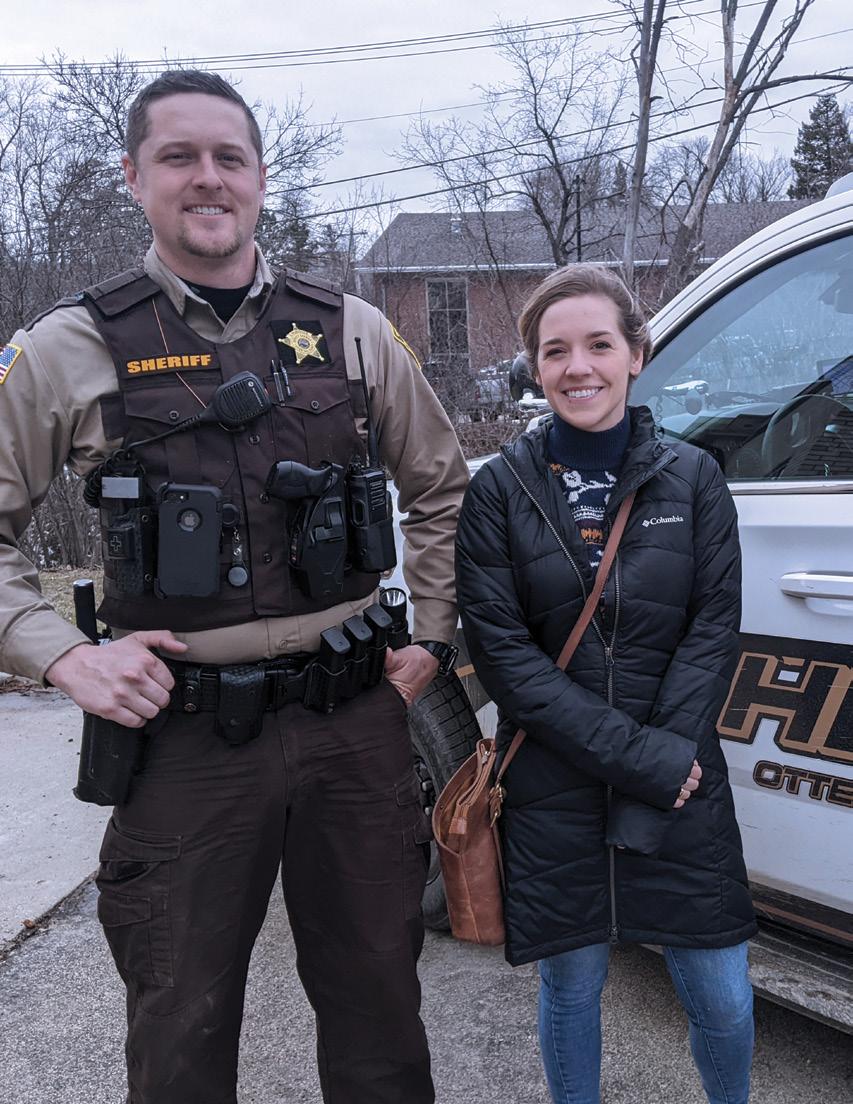 Sheriff Deputy Colby Palmersheim and DNP student Nicole Hoffman during her ride along in Otter Tail County.
Sheriff Deputy Colby Palmersheim and DNP student Nicole Hoffman during her ride along in Otter Tail County.
SEEING MENTAL HEALTH THROUGH A DIFFERENT LENS
School partners with law enforcement for clinical experiences in rural Minnesota

An innovative learning strategy for students in the Doctor of Nursing Practice psychiatric mental health nurse practitioner specialty is giving them a better understanding of the intersection between mental health and law enforcement in rural communities.
Students in the pysch mental health specialty are required to complete a 40-hour rotation in rural Minnesota. Their clinical experiences have traditionally included community health clinics or private practice. Recently, their clinical experiences began including ride alongs with police officers and other law enforcement activities.
“Most of our students come from an inpatient practice setting, so this community experience has really opened their eyes to the resources available, and to the barriers and challenges,” says Professor Emeritus Merrie Kaas, PhD, APRN, PMHCNS, FAAN, who’s the principal investigator of a Minnesota Department of Health grant to ensure students are better prepared for rural practice.
“I think students are more aware of their responsibility of being a provider in a rural area.”
The school’s partnerships with police departments and sheriff’s offices are giving DNP students an opportunity to learn from experiences with law enforcement, whether it be responding to calls, in jails or through probation. Currently the school has partnerships with the Willmar Police Department and the Otter Tail County Sheriff’s Office.
“It allows them, as up and coming practitioners, to deeply think about patient-centered care when they see all these different interactions that a patient could have in their life. If they can also interact with those other entities so that the patient can have optimal care, that’s what we want. That’s what we all want,” says Laurissa Stigen, MS, RN, DNP clinical placement coordinator.
Ellie Rizor, DNP, who stayed for a week in Willmar, Minnesota for her rural rotation, says she was initially confused about being paired with law enforcement.
“Then I thought about it, and as an in-patient nurse, we have police come to drop patients off or when there is an assault on the unit. So I was interested to see their experience and what they are seeing on the streets. It’s
by Brett Stursa continued on page 30
www.nursing.umn.edu | 29
– Ellie Rizor
continued from page 29
different than what we see when we have patients with us,” says Rizor, who graduated in May.
Rizor said her ride along with a Willmar police officer was quiet, but interesting. “We talked about how he decides whether to take someone to the hospital or to jail. It was interesting to hear his side of it and to hear from him how hard it is to access mental health services there,” says Rizor. “It made me feel more connected to my community officers here.”
As a child and adolescent care provider, she knew the value of community partners, like schools and teachers. But the experience taught her police departments are important partners too. “They could use the help and I could use the help,” says Rizor.
Willmar Police Chief Jim Felt says these types of conversations and realizations are why he didn’t hesitate to partner when asked. “In talking with the officers, we deal with so many mental health types of calls every day. We thought this would be a great opportunity.
We can learn from students, and the students can see what’s happening from our perspective in dealing with mental health on the street,” says Felt. “We need better strategies for dealing with people who suffer from mental illness.”
During Nicole Hoffman’s clinical experience with the Otter Tail County Sheriff’s Department she got to witness how great the health care needs are in jail. “The nurse was doing the best she could, but it looked like the needs were greater than what she could provide,” says Hoffman, MN, RN.
During a ride along with a sheriff’s deputy she heard about how common mental health calls are in the community and the toll they take not only on the person experiencing them, but on responders as well.
“Their lives are so different than mine but we’re all the same,” said Hoffman. “It was an invaluable experience for me that gave me a better understanding of the struggles outside of the world I know.”
30 | MINNESOTA NURSING
• • •
“We talked about how he decides whether to take someone to the hospital or to jail. It was interesting to hear his side of it and to hear from him how hard it is to access mental health services there.”
PURSUING BETTER HIV OUTCOMES
PhD candidate Charles Osingada is studying the potential of telehealth to enhance HIV care in Uganda
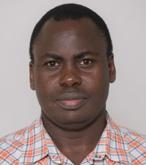 by Susan Maas
by Susan Maas
PhD student and Fogarty Global Health Fellow Charles Osingada remembers attending the rural funeral of a relative around 2000, when he had just completed his bachelor’s degree in nursing at Makerere University in Kampala, Uganda.
“I went home for a burial, and as I listened to people talking about the disease and how he struggled, I noticed that nobody was saying exactly what killed him. Even the children did not say anything about what killed their father,” Osingada recalls. “I asked around, and I was informed that he died of an HIV-related illness.” He suspected the stigma and silence around his relative’s diagnosis may have shortened his relative’s life.
“It made me think, how many such families existed in Uganda? How many people tried to avoid talking about this issue” – with likely implications for treatment and prognosis? “I wanted to understand, how big was this problem in Uganda, and in the region?”
Osingada combed the existing literature and found that no one was studying parents’ disclosure of HIV positive status to their children. That lack of knowledge, he realized, had implications for patient outcomes. “Number
one, people are not able to openly seek treatment,” says Osingada. “And it affects even those who are receiving treatment, because they are hiding, and probably cannot adhere to their medication, and they may be suffering psychological issues because of the distress that comes with keeping HIV status a secret.”
That experience helped set the course for Osingada’s career.
PURSUING BETTER HIV OUTCOMES
Osingada knew from childhood that he wanted to work in health. After attending nursing school, he continued his education with a master’s degree in bioethics from Case Western University in Cleveland in 2005.
He returned to Kampala, lecturing, treating patients, and completing administrative work, before the research bug led him to apply for master’s degree program in public health at Makerere. “There wasn’t a lot of research being conducted by nurses in Uganda,” says Osingada. “There were not many role models to look up to.”
www.nursing.umn.edu | 31
continued on page 33
Charles Osingada
Charles Osingada, after a focus group discussion with HIV counselors to explore their perceptions about the use of telehealth for follow-up HIV care at Kitebi Health Centre, Kampala, Uganda.

32 | MINNESOTA NURSING
from page 31
As his interest in community health and public health nursing grew, Osingada completed a one-year global health fellowship through Afya Bora Consortium Fellowship in Global Health Leadership, a partnership of eight academic centers in Africa and the U.S. During that program, Osingada wrote a proposal that was ultimately funded, a moment he calls “a giant step” in his career. The title of the proposal was Parental Disclosure of their HIV status to their Children: Prevalence, Associated Factors and Parents’ Experiences
Osingada built on that research in 2017 with a NURTURE (Research Training and mentoring program for career development of faculty at Makerere University College of Health Sciences) Fellowship. The project aimed at examining men’s perceptions and willingness to participate in HIV testing services offered at venues telecasting European football games in Kumi district, Uganda. He surveyed men gathered in bars to watch soccer matches on television about their willingness to be tested “and what would need to be put in place for that to be successful,” Osingada says. “I did focus group discussions, collecting their views about conducting HIV testing in those kinds of venues, where men come to watch football.
“They were very open to the idea,” he says. “Men did not want to encounter health care workers from their local community ... again, stigma.” However, he found promise in offering testing and treatment in locations away from home, with health workers who don’t personally know the patients.
Meeting Professor Carolyn Porta, PhD, RN, FAAN, FNAP, in Kampala in 2017 piqued Osingada’s interest in the University of Minnesota. He began at the University in 2019, with Porta as his adviser. She encouraged him to apply for the Fogarty Global Health research fellowship in 2020 and helped review his application package. Osingada was awarded the Fogarty fellowship in 2021; he’s one of seven trainees with research projects in Uganda.
‘TAKE ADVANTAGE OF WHAT’S BEFORE US’
For the fellowship and his PhD dissertation Osingada is studying the potential of telehealth to enhance HIV care in Uganda. He’s spent the past six months interviewing and working with both patients and health care workers in his home country. Osingada also was awarded a U of M Doctoral Dissertation Fellowship – from a pool of 200 applicants across the University – to help complete the project and his PhD.
Osingada’s idea coincided with COVID-19, which spurred greater investment in internet technology in many African countries. “I saw that we are probably not going to go back to pre-pandemic times,” he says. “So I thought, we can take advantage of what is before us and improve on the delivery of services to clients living with HIV in developing countries.” He hopes to complete the project by spring 2023.
There’s another reason Osingada has remained passionate about improving outcomes for patients with HIV. “I have a sister who has lived with the disease for more than 10 years. I have seen how she’s struggled; I’ve seen her life change,” he says. “I’ve seen her be able to bring up her children because she is adhering to her treatment. We would have lost her a long, long time ago otherwise. I have seen her live long because of the support we give her. It informs my interest in making sure that people with HIV access and remain on treatment.”
www.nursing.umn.edu
| 33
• • •
“We can take advantage of what is before us and improve on the delivery of services to clients living with HIV in developing countries.”
–
PhD student Charles Osingada
continued
SCIENCE MEETS CARING
Senior Brooklynn Isley says nursing is the right path for her
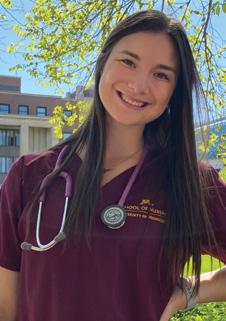 by Kim Kiser
by Kim Kiser
A high school health careers class got Brooklynn Isley thinking about majoring in nursing.
“I was drawn to the fact that it tied together two things I love: learning about science and caring for people,” she says. As she talked to family members and others in the profession, she learned about various specialties in which nurses practiced and the many types of jobs they held. “I could be a school nurse. I could be a hospital or clinic nurse. I love that freedom,” she says.
Isley was accepted into the University of Minnesota’s School of Nursing as a freshman. Having a direct path, rather than needing to complete prerequisites and general studies before applying to the school as is the protocol at many colleges and universities, was important to the senior from New Prague, Minnesota, who has been working several jobs to pay her way through college.
Last summer and fall, she served as a nursing assistant at Children’s Minnesota. Although it provided good experience, working 12-hour overnight shifts on weekends and one day during the week at the hospital was a large undertaking. “I loved the job,” she says. “But working overnight shifts and trying to maintain school, rest, and have a social life was impossible.”
Isley also works with children with disabilities as a substitute paraprofessional in the New Prague schools when she’s home and is a nanny for a family one day a week.
She says receiving a Discovery Scholars scholarship was a relief. “Knowing I have this extra support is stress-
relieving. It’s brought me a lot more peace.”
This year, Isley has been working alongside doctors and nurses, as she completes her nursing rotations. She also is a program director for the Minnesota Student Nursing Board and helped organize a spring careers week, during which recent graduates spoke to students about making the transition from school to work. “I love being on the board,” she says. “I’ve made great connections with upper and lower classmen.”
Brooklynn Isley
She says her rotations have confirmed she chose the right path. During a recent experience in the cardiac unit, she wanted to be with one of her patients who was having a procedure done. The patient, a 90-year-old woman, was frail and needing support.
Isley talked to her and held her hand. “I think of the smile she gave me, even though she wasn’t feeling well and was going through this uncomfortable procedure, and I know it’s why I picked nursing,” she says. “There was something extraordinary about sitting there holding her hand that will stick with me forever.”
34 | MINNESOTA NURSING
NURSING INFORMATICS SERIES EXAMINES DIGITAL HEALTH

Delaney, Pruinelli serve as editors
by Brett Stursa
A new book series examines digital health and its opportunities for nursing and patient health. Nursing and Informatics for the 21st Century – Embracing a Digital World, 3rd Edition is a four part series, published by Routledge/Productivity Press and HIMSS publishing. It is edited by School of Nursing Dean Connie White Delaney, PhD, RN, FAAN, FACMI, FNAP, and Associate Professor Lisiane Pruinelli, PhD, RN, FAMIA. Additional editors include Charlotte Weaver, PhD, MSPH, RN, FHIMSS, FAAN; Joyce Sensmeier, MS, RN-BC, FHIMSS, FAAN; and Patrick Weber, MA, RN, FIAHSI, FGBHI.
“Nursing is urgently being called to lead an unparalleled transformation of health care that is unwaveringly person-center, connected and accessible,” says Delaney. “This series abandoned the centrality of the electronic health record and calls for embracing a digital world that addresses social determinants of health, welcoming the empowerment of global vision and the ethic of equity. This series celebrates all who are co-creating with intentionality an informatics-anchored future that integrates and radiates the heart of intellect and wisdom, the brain of heart and compassion, and the action and impact of voice, caring, and awakening.”
Nursing and Informatics for the 21st Century — Embracing a Digital World, 3rd Edition is comprised of four books, including:
• Book 1: Realizing Digital Health – Bold Challenges and Opportunities for Nursing
• Book 2: Nursing Education and Digital Health Strategies
• Book 3: Innovation, Technology, and Applied Informatics for Nurses
• Book 4: Nursing in an Integrated Digital World that Supports People, Systems, and the Planet
“This 3rd edition of Nursing Informatics for the 21st Century reflects the current state of technologies and systems influencing people’s health. The books challenge the readers to think not just about all the informatics advancements over the recent years, but to be open to the paradigm shift that patient-centered care delivery is taking,” says Pruinelli.
“The fast implementation of digital technologies, AI-driven tools, sensors,
wearables and even social media, for example, are already influencing us every day. These books discuss how nurses and multidisciplinary teams have a key role in facilitating this process, at the same time educating and engaging patients for better shared-decision making.”
School of Nursing authors include Robin Austin, PhD, DNP, DC, RN-BC, FAMIA, FNAP; Thomas Clancy, PhD, MBA, RN, FAAN; Joanne Donnelly, DNP, APRN, CRNA; Martin Michalowski, PhD, FAMIA; Karen Monsen, PhD, RN, FAMIA, FNAP, FAAN; Nellie Munn Swanson, DNP, MPH, APRN, CPNP-PC; Carolyn Porta, PhD, MPH, RN, SANE-A, FAAN, FNAP; Teddie Potter, PhD, RN, FAAN, FNAP, Sripriya Rajamani, PhD, MBBS, MPH, FAMIA; and Cynthia Sherraden Bradley, PhD, RN, CNE, CHSE.
www.nursing.umn.edu | 35
From left, Connie White Delaney, Joyce Sensmeier and Lisiane Pruinelli, along with Charlotte Weaver and Patrick Weber, edited a new book series that examines digital health.
OUTREACH
“We believe and know that nursing is a potent pathway for not only the voice of people but for equity. Underneath it all, that’s what drives our involvement and our conversations at this conference," said Dean Connie White Delaney, at the June conference.

36 | MINNESOTA NURSING
10TH ANNUAL NURSING KNOWLEDGE: BIG DATA SCIENCE CONFERENCE CELEBRATES ACHIEVEMENTS, SETS VISION FOR FUTURE
by Brett Stursa
The 10th annual Nursing Knowledge: Big Data Science (NKBDS) Conference brought national experts to Minneapolis to discuss the future of nursing informatics and its alignment with the NKBDS strategic plan.

The conference, held June 8-10, 2022, celebrated the initiative’s accomplishments over the past decade and set a strong vision for the years ahead.
“The passion that birthed this conference was about the transparency and visibility of the voice of all people,” said Dean Connie White Delaney, PhD, RN, FAAN, FACMI, FNAP. “We believe and know that nursing is a potent pathway for not only the voice of people but for equity. Underneath it all, that’s what drives our involvement and our conversations at this conference.”
Together with NKBDS Co-Chair Lisiane Pruinelli, PhD, RN, FAMIA, they discussed the evolution of the conference, which began as an invitational with a thinktank commitment. “Nursing had been at the forefront of the informatics transformation but it wasn’t as empowered to make a difference,” said Delaney, noting the conference sought to provide that empowerment.
Over the years, a preconference was added with an emphasis on education to inform conference work and work groups composed of volunteers focused on specific topics aligned with the NKBDS vision who work throughout the year. There are now 160 people engaged in year round work groups. They have created more than 200 presentations and 140 publications over the years.
With the work group growth, dissemination of their work became a priority, to make it visible to the broader public. The Nursing Big Data Repository was created and more than 600 people are engaged with the listserv.
Delaney called last year a pivotal moment when the vision and mission were redefined and the 2021-2026 strategic plan was created for targeted actions.
The NKBDS steering committee oversees the initiative, which includes the work groups, conference and repository.
“It is all about better health outcomes and that comes from shareable, comparable data,” said Delaney.
PANEL TOPICS INCLUDE NATIONAL PATIENT OUTCOME INITIATIVES, FUTURE OF ARTIFICIAL INTELLIGENCE
The conference included the panel discussion National Patient Outcome Initiatives at the Intersection of Nursing, Informatics, and Big Data moderated by Judy Murphy, RN, FACMI, LFHIMSS, FAAN, with Victoria L Tiase, PhD, RN-BC, FAMIA, FNAP, FAAN – The Future of Nursing Report; Marisa Wilson, DNSc, MHSc, RN-BC, CPHIMS, FAMIA, FIAHSI, FAAN – The AACN Essentials; and Joyce Sensmeier, MS, RN-BC, FHIMSS, FAAN – The Unique Nurse Identifier.
Catherine Ivory, PhD, RN-BC, RNC-OB, NEA-BC, FAAN, moderated the panel discussion Artificial Intelligence Informed by Big Data: Challenges and Future Potential with Asta Thoroddsen, PhD – ICNP; Kenrick Cato, PhD, RN, CPHIMS, FAAN – Artificial Intelligence; and Laura Heermann Langford, PhD, RN.
The 11 work groups reported on major achievements in 2021 and discussed top priorities for the coming year.
The closing panel Ethical, Social and Workforce Considerations for Nursing, Big Data & Artificial Intelligence, was moderated by Martin Michalowski, PhD, FAMIA, with Rebecca Freeman, PhD, RN, FAAN, FNAP - How AI can help to decrease the nursing work/ mundane work?; Alain Junger, MS, RN - Social/Human/ Patients’ rights/privacy in front of AI; and Martha Turner, PhD, RN-BC, FAAN – Ethical implications of building, implementing, using artificial intelligence.
The 2023 conference will be June 7-9, 2023, in Minneapolis.
www.nursing.umn.edu | 37
NEW CODES BRING BETTER TREATMENT TO PATIENTS WITH MOISTUREASSOCIATED SKIN DAMAGE
Bliss served on WOCN Society leadership taskforce that ushered the policy change
by Brett Stursa
Eight new codes for moisture-associated skin damage (MASD) conditions were added to the International Classification of Diseases, Tenth Revision, Clinical Modification (ICD-10-CM) after a Wound, Ostomy, and Continence Nurses (WOCN) Society leadership task force, including Professor Donna Bliss, PhD, RN, FGSA, FAAN, advocated for the policy change.
“In terms of the impact, this is really significant,” says Bliss. “We are able now to track and monitor these conditions and interventions for these conditions in a way that we haven’t before. It is really a long time in coming.”
MASD occurs when skin becomes inflamed or eroded because of prolonged exposure to moisture or irritants, such as urine, feces, digestive secretions or wound drainage. It is uncomfortable for the patient, feeling like sunburn, and can develop into more severe skin problems.
“The good news is it is very preventable and very manageable,” says Bliss. “This is one of those interventions where nurses can make a big impact. It can be prevented, it can be treated in a way so that it doesn’t develop into a more serious problem.”
Now with the specific diagnostic codes, there will be better ways of tracking MASD.
ICD-10-CM is a system used by health care providers to classify and code all health-related diagnoses, symptoms and procedures. Used for medical claim reporting in health care settings, ICD-10-CM codes are used to establish necessity for payment of health care services and procedures. The WOCNS application was approved by the ICD10 Coordination and Maintenance Committee, which is a federal committee comprised of representatives from the Centers for Medicare and Medicaid Services and the Centers for Disease Control and Prevention’s National Center for Health Statistics.
The new codes will now enable nurses and other health care practitioners to code and bill for treating specific MASD conditions, which was not possible without the ICD-10-CM codes.
The new codes include:
• L24A0 Irritant contact dermatitis due to friction or contact with body fluids, unspecified
• L24A1 Irritant contact dermatitis due to saliva
• L24A2 Irritant contact dermatitis due to fecal, urinary or dual incontinence
• L24A9 Irritant contact dermatitis due friction or contact with other specified body fluids
• L24B0 Irritant contact dermatitis related to unspecified stoma or fistula
• L24B1 Irritant contact dermatitis related to digestive stoma or fistula
• L24B2 Irritant contact dermatitis related to respiratory stoma or fistula
• L24B3 Irritant contact dermatitis related to fecal or urinary stoma or fistula
CODES BRING THE POTENTIAL OF BIG DATA ANALYSIS
As a nurse researcher focusing on the epidemiology, assessment and management of incontinence and incontinence associated skin problems such as irritant contact dermatitis due to fecal, urinary or dual incontinence, Bliss is excited about what the new codes will mean for improved patient care and better health care provider education.
38 | MINNESOTA NURSING
“I am very excited for the potential of big data analysis. We will be able to analyze large, national data sets that have these codes in them and develop more conclusive answers to our clinical and research questions. We’ll be able to analyze how interventions and treatments may improve the conditions — or not — over time,” says Bliss. “Studies up until now have been limited by the small number of sample sizes.”
Bliss is now turning her attention to ensuring that clinicians have knowledge of MASD and the new codes. She was the lead author of the task force that published a pictorial practice alert article informing wound ostomy and continence nurses and other health care practitioners about the new ICD-10-CM codes and explaining their application to MASD conditions. She is also presenting at regional meetings and conferences to increase awareness.
“This policy change empowers nurses to have their practice and their interventions recognized in terms of making a difference in better patient outcomes,” says Bliss.
LEARN MORE
The practice alert New ICD-10 Codes for MASD was published in the Journal of Wound, Ostomy and Continence Nursing Read it by visiting z.umn.edu/icd10.

UPWARD VOYAGE
Ryan Marczynski returns to the Navy as an officer, with his BSN and a bevy of practical experience
by Tom Ziemer
When Ryan Marczynski, BSN ’22, started nursing school in 2019, it didn’t take him long to notice a fairly stark difference in the way he approached deadlines compared to some of his classmates.
Whereas Marczynski steadily worked on projects and prepared for exams with the sort of strict discipline you’d expect from an experienced U.S. Navy corpsman, others displayed the kinds of procrastinating study habits for which college students are well known.
After all, Marczynski had to remind himself, these students were just a handful of years older than his 15-year-old daughter. “Through two deployments, I had to lead 56 corpsmen on each deployment. And so just learning how to work with other people who have different backgrounds, have different experiences, that definitely helped me,” says the San Diego native.
Three years later, Marczynski has his degree from the University of Minnesota School of Nursing and is preparing for his next challenge: as a commissioned officer
with the rank of ensign, working at the U.S. Naval Hospital Okinawa in Japan, the Navy’s largest overseas hospital. He’ll carry valuable experience with him, having completed his clinical rotations at Mayo Clinic during his final two years at the School of Nursing’s Rochester, Minnesota, campus. While in the operating room, Marczynski saw how Mayo teams integrated the latest evidence-based research into their work on a daily basis.
“All the nurses at Mayo went out of their way to help you to learn and to experience more than maybe if you were at a different hospital,” he says. “Just their dedication to being the best they can is amazing to see. And every nurse who I worked with, I had that same experience with. They wanted to be the best that they could for the patients. It was just amazing to see how much these nurses cared.”
Marczynski completed his clinical capstone project in the emergency room at Mayo, a setting he’s keen to return to down the road. He’s gained plenty of experience in intense environments since serving as an EMT for several years after high school. At 21, he enlisted in the Navy as a hospital corpsman, meeting his wife, Wakana, during his first tour of duty in Okinawa.
continued on page 42
40 | MINNESOTA NURSING
ALUMNI SPOTLIGHT
BSN grad Ryan Marczynski asked Clinical Associate Professor Samantha Sommerness to be his officiating officer at his commissioning ceremony and issue him the oath of office.
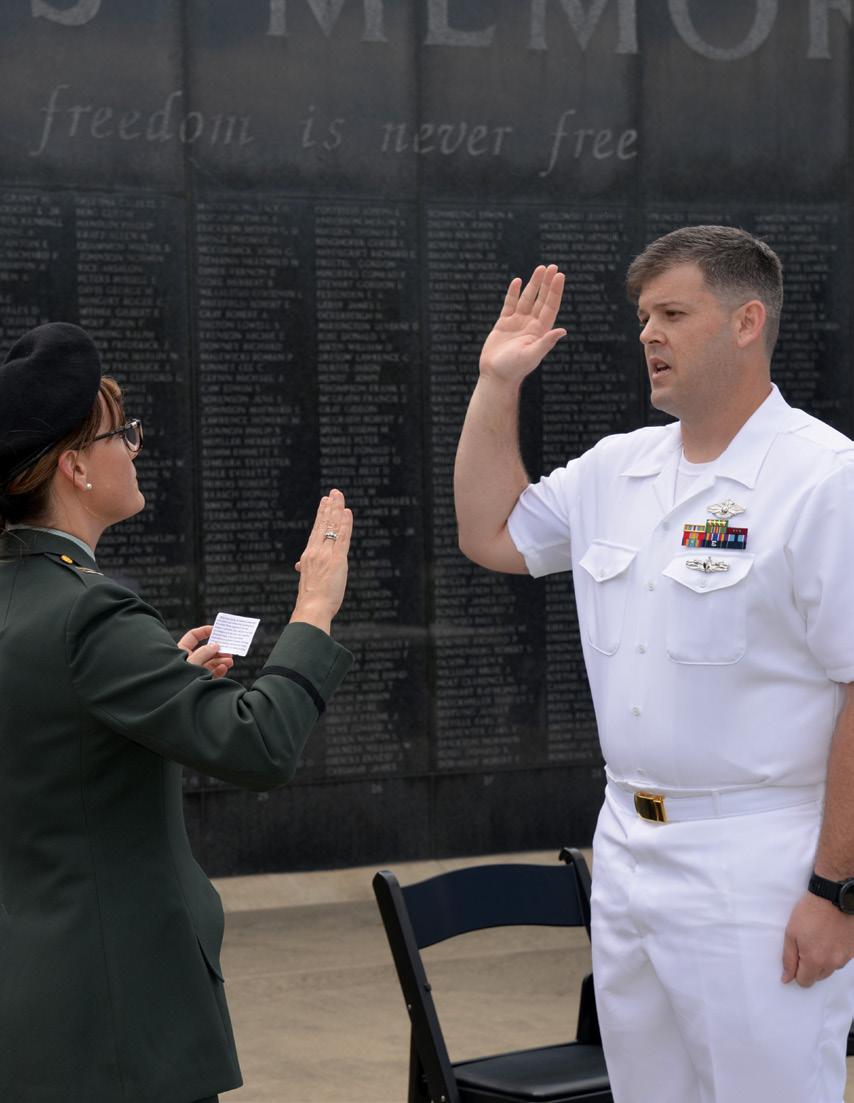
continued from page 40
Later, while stationed in Virginia Beach, Virginia, he led pre-deployment medical training for Navy SEAL and Explosive Ordnance Disposal teams, taught combat first aid and learned to provide care in a hyperbaric chamber for dive injuries.
But he wanted to further elevate his career, so he applied for the Navy’s Medical Enlisted Commissioning Program, allowing him to pursue his BSN degree and become a commissioned officer in the Navy Nurse Corps.
As the son of two Michigan State University graduates, Marczynski had his heart set on attending a Big Ten Conference school and was thrilled to get accepted into the University of Minnesota School of Nursing program located in Rochester.
His three kids were excited to see snow after living in the warm climates of Okinawa, San Diego and Virginia Beach. In Minnesota his family found they loved making snowmen and building snow castles, and Marczynski discovered a newfound respect for another branch of the service. One of the first things he recalls from a course about caring for families was Clinical Associate Professor Samantha Sommerness, DNP, APRN, CNM, mentioning her prior service as a nurse in the Army.
“There’s always the joke about the Army and Navy going back and forth, but she was great,” says Marczynski. “You could tell that she really cared for what she was teaching and making sure that people weren’t just memorizing and forgetting after the test, but really taking it to heart.
When it came time for me to get an officer who I wanted to be my officiating officer at the commissioning ceremony and issue me the oath of office, I couldn’t think of anybody but her. I feel so lucky to be able to have her
Ryan Marczynski
as my commissioning officer and have her being part of this whole experience.”
Now a commissioned officer, Marczynski is excited for his career to come full circle and return to Okinawa. He’ll begin working in a multiservice ward, though he’s already planning to pursue his flight nurse certification.
Although he’ll be deployed nearly 7,000 miles away, Marczynski expects to remain closely connected to Rochester. His eldest daughter began her journey to a nursing degree on the Rochester campus this fall.
Despite the family being so far away, Marczynski knows she’ll be in good hands.
“Our cohort became like a small family,” he says. “My classmates have already said that if she ever needs anything, just to let them know and they’ll be more than happy to help out.”
42 | MINNESOTA NURSING
• • • “ All the nurses at Mayo went out of their way to help you to learn and to experience more than maybe if you were at a different hospital. Just their dedication to being the best they can is amazing to see.”
–
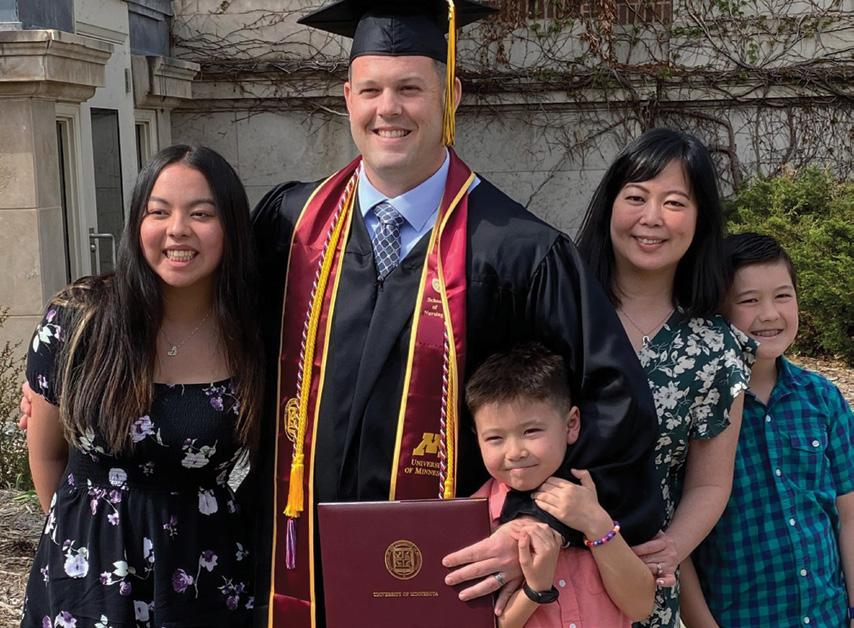
www.nursing.umn.edu | 43
Ryan Marczynski and his family at his graduation ceremony at Northrop in May.
ALUM MAY HANG CHAIRS
FIRST HMONG NURSES
ASSOCIATION CONFERENCE
CTSI grant funds pilot study conducted in partnership with faculty
by Brett Stursa
May Hang, DNP ’19, APRN, FNPBC, a graduate of the University of Minnesota’s Doctor of Nursing Practice program, joined the Hmong Nurses Association (HNA) for support and leadership opportunities.
This summer, she chaired the first HNA National Conference and partnered with Associate Professor Rozina Bhimani, PhD, DNP, APRN, CNP, CNE, CRRN, to complete a needs assessment at the conference.
“I am interested in mentoring diverse nursing students, as I also faced much adversity, overcoming barriers in my pursuit of higher education, social justice and representation in health care,” says Hang. “So, for me being involved with HNA is the perfect opportunity.”
HNA formed in 2012 in response to a lack of representation of Hmong in the health care profession.

The vision for the two day conference, held Aug. 5-6 in St. Paul, was to provide information about Hmong culture, beliefs and practices related to health and illness, provide strategies to help close the gap in health
care disparities, and offer sessions to sharpen nursing skills when providing care for the Hmong community. They designed the conference to support self-healing and increase Hmong nurse resiliency. “The conference provided Hmong nurses an opportunity to come together to identify critical issues facing the Hmong community due to the pandemic and existing health disparities in our society, which are impacted by social, political and workforce issues,” says Hang.
CTSI AWARDS COMMUNITY PARTNERSHIP GRANT
The conference served as a venue to collect Hmong nurses’ stories, insights and feedback for a needs assessment to understand any disproportionate effects of COVID-19 in the Hmong community and identify culturally appropriate interventions.
“Hmong nurses working in all settings — outpatient, in patient, and public health — relayed stories of Hmong patient isolation, breech of cultural practices and values, trauma related to physical disability of long hauler syndrome and mental anguish resulting in grief and loss,” says Hang.
Hang and Bhimani received an inaugural Clinical and Translational Science Institute Community Partnership Grant for the pilot study.
44 | MINNESOTA NURSING
Both Hang and Bhimani serve as nurse practitioners at NorthPoint Health and Wellness Center, which is a federally qualified health center located in north Minneapolis. Bhimani also served as Hang’s adviser for her DNP scholarly project, which involved developing a smoking cessation program within NorthPoint.
“This was a golden opportunity to collect information about how COVID has impacted nurses and how it has affected cultural practices,” says Bhimani, who developed a survey for the needs assessment and will complete the data analysis.
“We are looking at long-term engagement. We hope to design an intervention to bridge the suspected gap
in cultural practices caused by COVID,” says Bhimani.
“When we talk about equity and social justice we really need to not only talk about it but we need to meaningful engage in that work. That’s why I feel very lucky to be invited into this space so we can work together to benefit the community.”
For more information about the Hmong Nurses Association, visit www.hmongnurses.com.
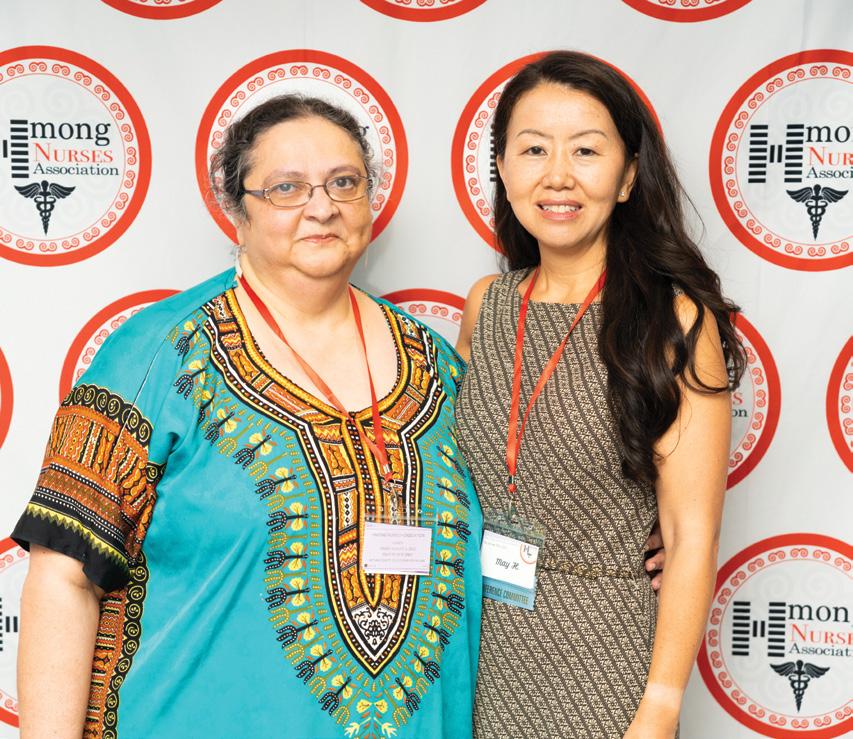
www.nursing.umn.edu | 45
Photo: Darin Kamnetz
Associate Professor Rozina Bhimani and Alum May Hang received an inaugural Clinical and Translational Science Institute Community Partnership Grant to conduct a needs assessment at the first-ever Hmong Nurses Association Conference.
LEARN MORE
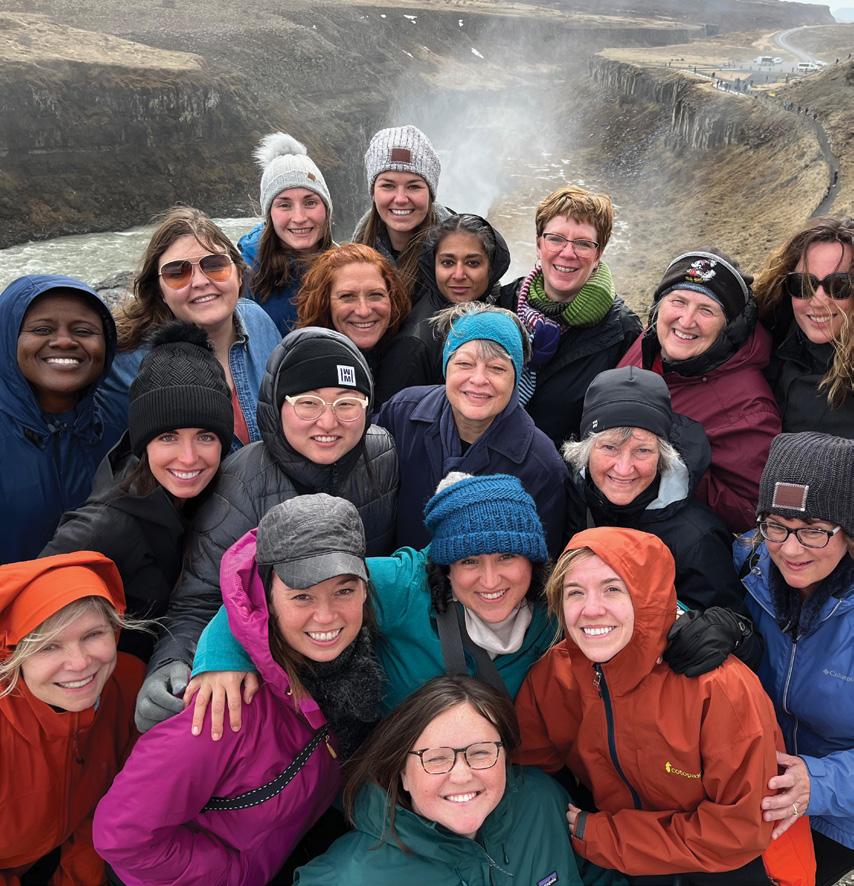
46 | MINNESOTA NURSING SCHOOL NEWS
DNP students in Global Health and Management course traveled to Iceland with faculty in May.
UNIVERSITIES OF ICELAND, MINNESOTA CELEBRATE 40-YEAR PARTNERSHIP
Recent signing extends partnership another 5 years
by Brett Stursa
For 40 years, the University of Minnesota and the University of Iceland have fostered a partnership spanning research collaboration and student and faculty exchange.
That milestone was celebrated in September in Minneapolis. Jón Atli Benediktsson, rector of the University of Iceland, and Joan T.A. Gabel, president of the University of Minnesota, signed an agreement extending the partnership between the universities by another five years.
“This 40-year partnership is exemplary in advancing excellence in nursing and multiple disciplines in transformative impact in academia, research, mutual learning about health systems and the health of the people and environment. The partnership exemplifies celebration of relationships, cultures and values,” says Dean Connie White Delaney, PhD, RN, FAAN, FACMI, FNAP, who also holds an adjunct professorship at the University of Iceland in both the Faculty of Nursing and the Faculty of Medicine.
In 1982, the University of Minnesota became the first university abroad to sign a bilateral partnership agreement with University of Iceland. Over the years, there has been extensive collaboration between the nursing schools in Iceland and Minnesota.
“The partnership between the faculty of Nursing and Midwifery at the University of Iceland and the School of Nursing at the University of Minnesota has not only added value to the program for students but
Joan T.A. Gabel, president of the University of Minnesota, and Jón Atli Benediktsson, rector of the University of Iceland, signed an agreement extending the partnership between the universities by another five years.

has also been valuable for the faculty involved,” says Helga Bragadóttir, PhD, RN, FAAN, dean of nursing at the University of Iceland. “The curriculum becomes manifold and richer, with students as well as faculty attaining increased global leadership skills and cultural competence besides students getting exposed to the content of the courses. For our students in Iceland this collaboration had made a huge difference in their education and career development.”
Annually, the School of Nursing offers a global health and management course in Iceland that focuses on international nursing leadership and employee management grounded in population health.
“We are so grateful for the partnership with the University of Iceland,” says Judy Pecachek, DNP, RN, CENP, assistant dean, Doctor of Nursing Practice Program, who co-teaches the course. “Each year we partner with Iceland leadership faculty to co-teach a course with U.S. and Icelandic nursing leadership students focused on different models of health care delivery and explores the impact of a single payer system. Our University of Minnesota students experience life changing health care delivery in a technologically and socially advanced nation.”

www.nursing.umn.edu | 47
DENSFORD CENTER BEGINS NEXT ERA WITH NEW VISION, LEADERSHIP MODEL AND DIRECTORS
by Brett Stursa
The Katharine J. Densford International Center for Nursing Leadership begins a new era in its storied history with the naming of new directors and the adoption of a new vision, mission and leadership model.
With the retirement of the center’s former director Daniel Pesut, PhD, RN, FAAN, and a reflection and celebration of the inaugural director Mary Jo Kreitzer, PhD, RN, FAAN, and longstanding director Joanne Disch, PhD, RN, FAAN, the School of Nursing announced a new directorate model of leadership and new directors. The new directors include:
• Shirley Brekken, MS, RN, FAAN, a nationally recognized accomplished leader in nursing regulation having served as the chief executive officer for the Minnesota Board of Nursing 1999-2021
• Siobhan McMahon, PhD, MPH, GNP-BC, associate professor at the School of Nursing, a gerontological nurse practitioner, and nurse researcher with a focus on promoting health and wellness across diverse older adult populations with fall risk
• Vincent Peters, MASW, inaugural director of community engagement at the School of Nursing, who

previously served as assistant provost for the Office of Off-Campus Programs and International Studies at Bethel University, pioneering various initiatives to foster students’ active engagement in local communities through Academic Service-Learning, vibrant campusurban community partnership, and robust study abroad opportunities
• Teddie Potter, PhD, RN, FAAN, FNAP, clinical professor, inaugural director of Planetary Health, specialty coordinator of the Doctor of Nursing Practice in Health Innovation and Leadership, and holder of the Pauline A. Vincent Chair of Public Health
• Holly Shaw, PhD, RN, represents the International Council of Nurses within the United Nations system, including Civil Society leadership in appointed and elected positions in the Department of Global Communication and the Economic and Social Council.
Dean Connie White Delaney, PhD, RN, FAAN, FACMI, FNAP, will serve as ex officio director, and Midori Green, PhD, will continue to serve as center administrator.
“The Katharine J. Densford International Center for Nursing Leadership for 25 years has made indelible marks on nursing and leadership. As a school, society and world we are increasingly recognizing and celebrating our interdependency, interconnectedness and call for unwavering team, partnership, and
48 | MINNESOTA NURSING
Collaborations key to moving toward health equity and improved health
collaboration for deeply transformational impact,” says Delaney. “It is time for us to co-design and role model a new leadership model that exemplifies the mutual respect and interrelationship of tenure track/tenured and clinical track faculty and staff, local to global lens, and expanded partnerships. The directorate represents a team of mutual decision makers representing values and qualities of optimism, partnership, collaboration, humility, ‘we are,’ global/local, systems thinkers, emotional intelligence, self-awareness, and inclusivity, diversity and equity commitment. This team builds on the past and will expand honoring different ways of knowing and advocacy as foresight drives the wholeness
of head-heart essence to enhance the survival and vibrancy of nurses, nursing and leadership.”
The Densford Center’s new leadership recently adopted a new vision and mission.
The new vision is: Nurses will lead the collaborative transformation of individual, population, global and planetary health.
The new mission is: The Densford Center advances innovative leadership development of nurses and nursing through interprofessional education, research, advocacy and community engagement.
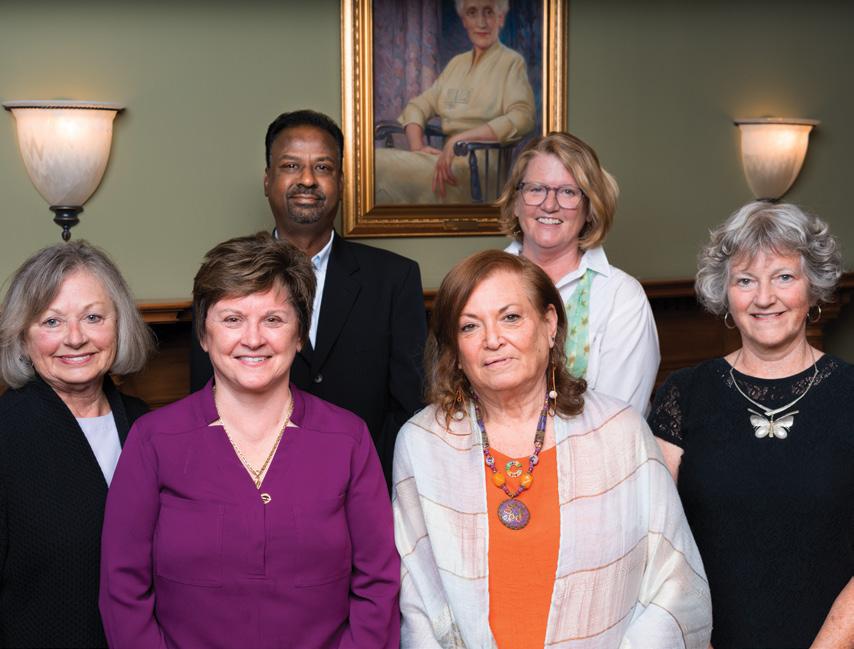
www.nursing.umn.edu | 49 continued on page 50
From left, Shirley Brekken, Connie White Delaney, Vincent Peters, Holly Shaw, Siobhan McMahon and Teddie Potter, with a portrait of Katharine J. Densford in the background.
Photo: Darin Kamnetz
continued from page 49
A STORIED HISTORY
Established in 1997, the Katharine J. Densford International Center for Nursing Leadership was the nation’s first university-based center dedicated to improving health care worldwide through the development and promotion of nurses as leaders. The Densford Center’s namesake, Katharine J. Densford, was the director of the University of Minnesota School of Nursing from 1930 to 1959. She held offices in almost every nursing organization of the time and, more importantly, was an agent for social change. The inaugural director of the Densford Center was Kreitzer, who led the center from 1997-2000. Disch, led the center from 2000-2012, and Pesut led it from 2012-2020.
NEXT ERA
The next era of the center builds upon and expands the foundational values of the center, including: committing to and engaging in relationships that promote “power with” rather than “power over” others; collaborating with interprofessional, transdisciplinary, community, and global partners to move toward health equity and improved health for everyone; honoring different ways of knowing, including personal, cultural, situational, ethical, empirical, and Indigenous knowledge systems; respecting the dignity and wellbeing of all; advocating for inclusivity, diversity, equity, and justice, working from a mindset of abundance rather than scarcity, and hope rather than fear; and considering policy implications for all initiatives and actions.
The adoption of initial initiatives by the directorate will lead the Densford Center into this new era. The new initiatives include:
• Academic, Practice and Community Partnerships: Invigorate the impacts of active collaboratories, community partnerships, and the University of Minnesota’s commitment to public engagement with research-based, results-oriented endeavors that ensure health equity and access is at the forefront of nursing practice.
• Establishing a Center for Nursing Leadership and Engagement at the United Nations: Through synergy with the Densford Center and the United Nations Center for Nursing Leadership and Engagement, promote preparation and engagement of nurses to represent underrepresented peoples in discussions about planetary health, human rights, global health and other global challenges at the United Nations.
• Cultivating Bold Visionary Leadership: Advance systems thinking and further develop the science and practice of leadership through interprofessional and transdisciplinary partnerships and innovative networks with local and global community partners.
• Nursing Impact: Key to a Viable and Vital Future: Engage communities and partner with legislators and interprofessional peers to champion policy reforms.
50 | MINNESOTA NURSING
• • • “
It is time for us to co-design and role model a new leadership model that exemplifies the mutual respect and interrelationship of tenure track/ tenured and clinical track faculty and staff, local to global lens, and expanded partnerships.”
– Dean Connie Delaney White
FRIEDRICH INDUCTED INTO THE AMERICAN ACADEMY OF NURSING
The American Academy of Nursing (AAN) announced that Clinical Professor Cheri Friedrich, DNP, APRN, CPNP-PC, IBCLC, FNAP, was inducted into the 2022 Class of Fellows.
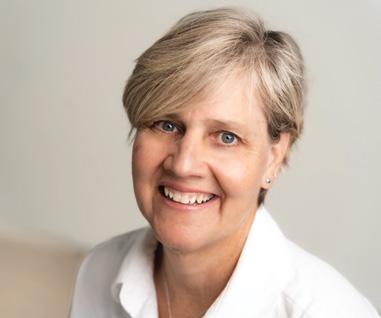
The achievement is considered one of the highest honors in the nursing profession.
Fellows are nurse leaders who are experts in policy, research, administration, practice and academia that champion health and wellness, locally and globally.
Friedrich is a leader in interprofessional education (IPE), advancing IPE across health professions internationally, nationally and locally. She co-developed and now serves as the co-director of the University’s Center for Interprofessional Health. She has transformed IPE across the University through collaborative internal and external partnerships, impacting the curriculum of over 1,000 students from multiple health professions programs each year. She is lead developer of two innovative interprofessional health care escape room experiences, downloaded more than 800 times and utilized in nearly every state and 12 countries.
She serves as the specialty coordinator for pediatric nurse practitioner-primary care and is a pediatric nurse practitioner in a federally qualified health center. She currently serves as president of the Association of Faculties of Pediatric Nurse Practitioners.
Cheri Friedrich
“At a time when investments in, and policy to address, health equity, innovation, and access are paramount, the Academy is thrilled to welcome these dynamic and courageous nurse leaders who will support our collective vision of healthy lives for all people,” said AAN President Kenneth R. White, PhD, RN, AGACNP, ACHPN, FACHE, FAAN. “Induction in the Academy is a powerful moment in a nurse’s career.”
Friedrich was the only Minnesota nurse inducted this year. An induction ceremony was held at AAN’s annual Health Policy Conference in October in Washington, D.C.
www.nursing.umn.edu | 51
SIX NAMED ENDOWED CHAIRS, PROFESSORS
The School of Nursing announced the appointment of six endowed chairs and professors. Clinical Professor Mary Benbenek, PhD, APRN, FNP-BC, CPNP-PC, FAANP, FNAP, Clinical Professor Cheri Friedrich, DNP, APRN, CPNP-PC, IBCLC, FNAP, Professor Susan O’Conner-Von, PhD, RN-BC, CNE, FNAP, and Clinical Professor Judith Pechacek, DNP, RN, CENP, were named as Katherine R. & C. Walton Lillehei Chairs in Nursing Leadership. Professor Jenna Marquard, PhD, was named Cora Meidl Siehl Chair in Nursing Research for Improved Patient Care. Associate Professor Erica Schorr, PhD, BSBA, RN, FAHA, was named a School of Nursing Foundation Research Professor. In addition to providing faculty with the resources necessary to propel their research and innovations, endowed chairs and professorships are essential for recruiting and retaining the highest-quality scholars. They help create an academic environment that attracts the best students by giving them access to key learning, often years before it appears in textbooks.
52 | MINNESOTA NURSING
KATHERINE R. & C. WALTON LILLEHEI CHAIR IN NURSING LEADERSHIP

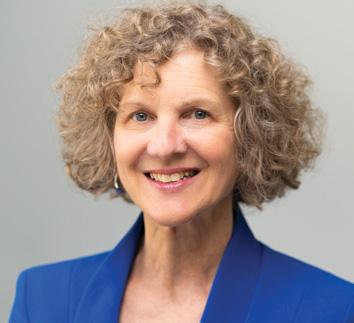
The Katherine R. & C. Walton Lillehei Chair in Nursing Leadership was created in 2001 in appreciation for the role the University played in their lives and in the belief that education holds a society together. It is named after Katherine R. Lillehei, a nursing student in the 1940s and former School of Nursing Foundation member, and her husband C. Walton, a renowned Minnesota physician and pioneer of open-heart surgery.
Benbenek is a recognized nurse leader, APRN clinical expert and global health champion. She is the first nurse practitioner to be appointed to the Drug Formulary Committee at the Minnesota Department of Health (MDH). She has served on MDH committees, local professional organization boards and national nurse practitioner organization projects. She has designed and implemented global partnerships and has worked to enlighten educational programs on global perspectives. She is a fellow in the American Association of Nurse Practitioners and the National Academies of Practice.
Friedrich is the specialty coordinator for the pediatric nurse practitioner (PNP) primary care track and the co-creator and co-director of the Center for Interprofessional Health. She is a national leader in developing innovative interprofessional health education approaches to support learners in interprofessional competency advancement. She led the development and implementation of interprofessional health care escape rooms, developed an innovative virtual interprofessional education (IPE) curriculum, and co-developed a continuing education series for clinical preceptors. Friedrich continues to support IPE as a practicing PNP and preceptor in a federally qualified health center. She is also a fellow of the National Academies of Practice and was inducted into the American Academy of Nursing in October 2022.
continued on page 54
www.nursing.umn.edu | 53
Mary Benbenek
Cheri Friedrich
continued from page 53
O’Conner-Von advances interprofessional health care through her program of research, teaching and service activities with a focus on holistic pain and palliative care. In the classroom, her personalized involvement with her students ignites passion for nursing research, professional development and life-long learning. She has received numerous awards recognizing her accomplishments, most recently her induction into the University of Minnesota Academy of Distinguished Teachers and the Rush University Nurses Alumni Association Excellence in Practice Award. She was on staff at Children’s Hospital in St. Paul for 33 years.
Clinical Professor Judith Pechacek, DNP, RN, CENP, is an innovative educator, quality scholar and academic program leader with a sustained national impact on education specific to executive leadership, quality, safety and interprofessional practice. She is deeply committed to an inclusive, diverse and equitable educational environment and experience for students. As the assistant dean of the Doctor of Nursing Practice (DNP) program, she leveraged innovative quality improvement initiatives, teaching strategies and faculty support to elevate the DNP program to No.7 in the 2023 U.S. News & World Report, Best Nursing Schools. In addition, Pechacek is a coach and mentor for both emerging and experienced leaders who seek to improve their leadership impact.
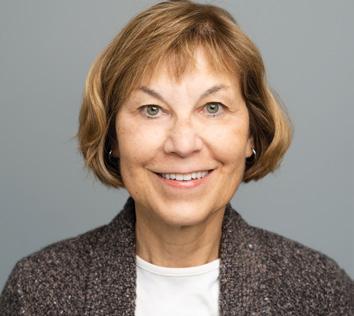
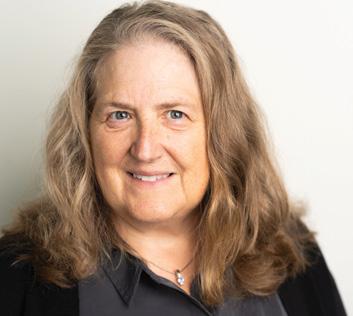
54 | MINNESOTA NURSING
Susan O’Connor-Von
Judith Pechacek
CORA MEIDL SIEHL CHAIR IN NURSING RESEARCH FOR IMPROVED PATIENT CARE
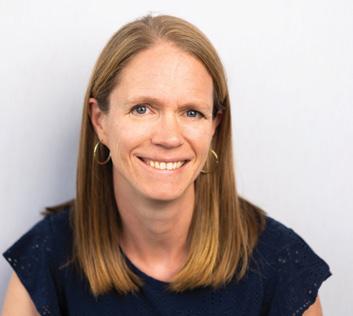
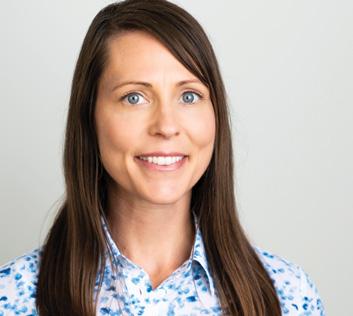
The Cora Meidl Siehl Chair in Nursing Research for Improved Patient Care was established in 1982 to celebrate the legacy of Siehl, a Class of 1931 graduate, and was a cornerstone in the creation of the school’s doctoral program. It was among the first endowed chairs in schools of nursing to focus on research.
Marquard is chair of the Population Health and Systems Cooperative. She uses her background in industrial engineering, and collaborations with nurses, to improve the design of technologies used by nurses and patients. She is committed to advancing nursing science by bringing together researchers and practitioners from diverse disciplines. She is also committed to teaching nursing students a broad set of engineering tools so they can make a significant impact on technology design. She has partnered with nurses on numerous grants funded by the National Institute of Nursing Research, Agency for Healthcare Research and Quality and National Science Foundation.
SCHOOL OF NURSING FOUNDATION RESEARCH PROFESSORSHIP
The School of Nursing Foundation Research Professorship was established in 2009 by supporters of the University of Minnesota to advance nursing science.
Schorr chairs the School of Nursing Research Committee. She is also a Fellow of the American Heart Association (AHA), chair and first-author of an AHA Scientific Statement on using mobile health technologies for secondary cardiovascular disease prevention in older adults, and co-author of an AHA scientific statement on physical activity as a critical component of first-line treatment for elevated blood pressure or cholesterol. Through national and international interdisciplinary collaborations, she has tested approaches that incorporate mobile health technologies to increase levels of physical activity, decrease sedentary time, improve medication adherence and enhance quality of life.
www.nursing.umn.edu | 55
Jenna Marquard
Erica Schorr
RIVET TO RECEIVE HONORARY DEGREE
Jeannine Rivet, MPH, BSN, RN, FAAN, will receive an Honorary Doctor of Laws degree from the University of Minnesota for her advancement of nursing and health care through public service.
The honorary degree is the highest award conferred by the University of Minnesota. An honorary degree is awarded to an individual who has achieved acknowledged eminence in cultural affairs, in public service, or in a field of knowledge and scholarship.
Rivet served as the executive vice president of UnitedHealth Group, where she worked in areas focused on strategic business relationships, clinician advancement, culture and social responsibility. She has served on numerous boards and committees, including the School of Nursing Dean’s National Board of Visitors, United Healthcare Children’s Foundation, and the Harvard School of Public Health, Health Policy and Management Executive Council.
“Jeannine Rivet has challenged the systemic barriers leading to the advancement of women to leadership positions in health care,” wrote Christine Mueller, PhD, RN, FGSA, FAAN, senior executive associate dean for academic programs, in her nomination letter. “Through her dedication to the mentorship of women, her impactful leadership role in the largest health and wellbeing company in the world, and leadership in boards and organizations, hundreds of women have been able to advance to significant leadership and executive roles, influencing health care systems to improve the health of individuals and communities.”
Rivet is the fifth recipient of an honorary degree who was nominated by the School of Nursing. Marie Manthey received an honorary degree in 1999, Maya Angelou in 2007, Brig. Gen. (ret.) Clara Adams-Ender in 2009 and Lt. Gen. (ret.) Patricia Horoho in 2014.
Rivet earned a bachelor’s degree in nursing from Boston College and master’s degree in public health from Boston University.
Rivet began her career as a pediatric nurse at Rhode Island Hospital. Later, in positions in the managed care industry, she developed new care models for population health management. She held a variety of influential leadership roles at UnitedHealth Group, including chief executive officer and president of Optum, with her final position as executive vice president.
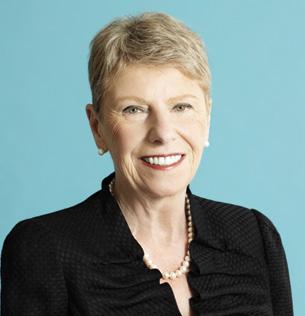
She received many honors to recognize her contributions in health care and leadership development of women, including being recognized by Fortune Magazine for three years as one of the 50 Most Powerful Women in American Business and receiving the 21st Century Pinnacle Leader Award by the Minnesota Women’s Leadership TRUST, the Twin Cities Business Magazine Lifetime Achievement Award and the Women’s Health TRUST Mentor of the Year Award. She was named a fellow in the American Academy of Nursing, considered one of the highest achievements in the nursing profession.
The honorary degree will be conferred at the Nursing Commencement Ceremony on Dec. 16 at Northrop Auditorium.
56 | MINNESOTA NURSING
Jeannine Rivet
THREE EARN THE SCHOOL’S HIGHEST HONOR FOR NON-NURSES
Michael W. Rohovsky, PhD, DVM, David A. Rothenberger, MD, and Dee Thibodeau were recognized with the School of Nursing’s Richard Olding Beard Award during a ceremony on Sept. 15.
The Beard Award, which was established in the school’s centennial year of 2009, recognizes non-nurses whose foresight, wisdom and courageous advocacy for the nursing profession have led to better health care for all.
Rohovsky is the former worldwide vice president of Research & Development for Johnson & Johnson, Orthopedics and Neurosurgery. A veterinarian by training, Rohovsky began his career as an assistant professor of veterinary pathology at The Ohio State University before becoming head of pathology at Merrell National Labs and later director of pathology for Arthur D. Little. Recognizing the interconnectivity of animal, human and planetary heath, Rohovsky has been a strong advocate for the expansion of interdisciplinary research and has helped the School of Nursing discover unique synergies in research and adopt more sustainable business practices.
Rothenberger is a physician leader, internationally recognized surgeon, mentor, researcher and former chairman of the Department of Surgery at the University of Minnesota. A lecture series bearing his name at the University is integrated with the curriculum of the Medical School’s Emerging Physician Leaders Program and aims to build on its traditions of health care, leadership and innovation. Rothenberger has been a leader in
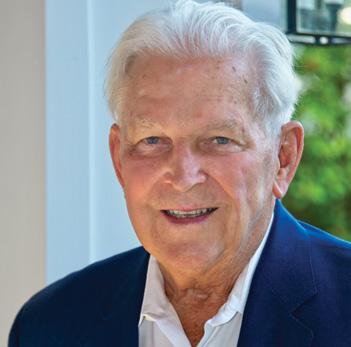
www.nursing.umn.edu | 57
Michael Rohovsky
Rohovsky, Rothenberger, Thibodeau awarded the Richard Olding Beard Award
continued on page 58
continued from page 57
shedding light on the burnout issues facing health care professionals and a champion of collaboration, mutual respect and the development of interprofessional health care teams to better care for patients. Throughout his career he has been a strong advocate for and valued partner of the nursing profession.
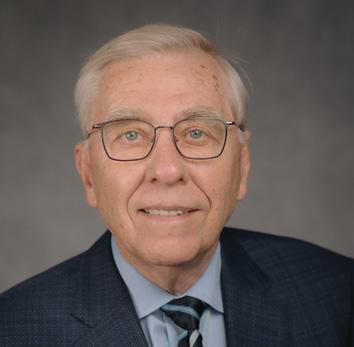
Thibodeau is a senior executive in the information technology industry, a dynamic leader of companies, an experienced board member and an accomplished investor in emerging companies. A natural connector, Thibodeau joined veteran women executives and angel investors to launch the Sofia Fund, which invests in women-led technology and health businesses. She has served on the board of directors of more than a dozen companies and organizations, including M Physicians and M Health Fairview. She has also chaired the Women’s Health Leadership Trust and served as board member for the Minnesota Visiting Nurses Association. Thibodeau has used her health care and technology experience to advance nursing and create an impact and vision in the health of the community.
RICHARD OLDING BEARD
Richard Olding Beard, chair of the physiology program at the University of Minnesota, is credited with bringing nursing into the institution of higher learning when the nursing program was established in 1909 at the University of Minnesota.
Beard passionately advocated for the advancement of nursing believing that educating nurses, rather than training them as had been the practice, would help society recognize the worth of human life, conserve human health and provide for social justice. Historian Deborah MacLurg Jensen has said Beard’s actions were, “a step of the greatest consequence for nursing education.” She proclaimed of his founding the School of Nursing at the University of Minnesota, “The final step in the creation of the nursing profession had been taken.”
Past recipients of the Richard Olding Beard Award include Frank Cerra, William Crown, Judi H. Dutcher, Richard Norling, John J. Spillane and Benjamin Mchie.

58 | MINNESOTA NURSING
Dee Thibodeau
David Rothenberger
AWARDS AND HONORS
Clinical Assistant Professor Linnea Benike, DNP, RN, PCCN, CNE, earned certification through the National League for Nursing as a Certified Nurse Educator (CNE).

Professor Donna Bliss, PhD, CCRN, was appointed to the Friends of the National Institute of Nursing Research Board of Directors. The two-year term will begin Jan. 1, 2023.
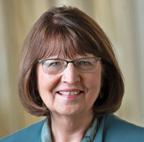
Assistant Professor Cynthia Bradley, PhD, RN, CNE, CHSE, will be inducted into the prestigious Academy of Nursing Education by the National League for Nursing.
Clinical Professor Cheri Friedrich, DNP, APRN, CPNP-PC, FNAP, is serving as president of the Association of Faculties of Pediatric Nurse Practitioners.
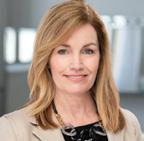
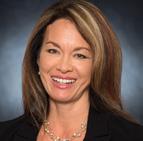
Clinical Associate Professor Lisa Martin, PhD, RN, PHN, AHN-BC, FAAN, was named a Global Health Scholar. Her area of interest as a global health scholar is a scoping review of the literature/ state of science on global Indigenization research and its application to nursing curricula.
Christine Mueller, PhD, RN, FGSA, FAAN, professor and senior executive associate dean for academic programs, served on the National Academies of Sciences, Engineering and Medicine Committee on the Quality of Care in Nursing Homes. Mueller was also appointed by Gov. Tim Walz to the Minnesota Board on Aging.
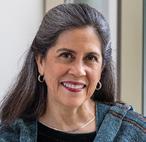
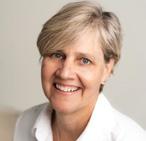
Clinical Assistant Professor Joanne Donnelly, DNP, APRN, CRNA, was elected to the Board of Directors for the Minnesota Association of Nurse Anesthetists.
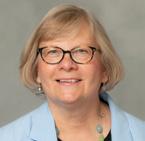
www.nursing.umn.edu | 59
NATIONAL SCHOOL OF PUBLIC HEALTH IN CUBA, UNIVERSITY OF MINNESOTA STRENGTHEN PARTNERSHIP
The National School of Public Health in Cuba and the University of Minnesota signed a memorandum of understanding (MOU) to strengthen their academic and research partnerships at a virtual ceremony in May.
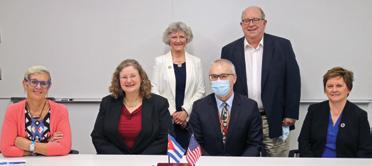
“It is my honor to represent the University of Minnesota at this historic event,” said Rachel T.A. Croson, University of Minnesota executive vice president and provost. “We are delighted to deepen this relationship with the people of Cuba and the National School of Public Health by signing this memorandum of understanding. We look forward to working collaboratively to discover and disseminate knowledge to benefit the people of Minnesota, Cuba, United States and the world.”
The purpose of the agreement is to establish a collaborative academic relationship between the two institutions to promote joint activities related to disease prevention, health care delivery, training of health professionals, and global and bilateral collaborations in health, epidemiological and medical research. It supports joint conferences, exchange of publications, and bilateral visits by students and faculty.
“The project was conceived several years ago and emerged from numerous and diverse exchanges between professors, researchers and students,” said Pastor Castell-Florit Serrate, director of the National School of Public Health. “The document that we signed today represents another step in the advancement of these exchanges that will
facilitate the path for future collaborations and alliances for the benefit of the health of our peoples and the planet.”
The institutions have a long history of collaboration, most recently on a series of COVID webinars with experts from Cuba and the University of Minnesota sharing emerging science and best practices.
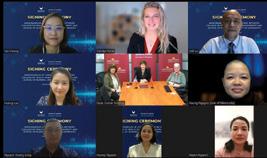
The MOU was signed by University of Minnesota representatives Connie White Delaney, dean of the School of Nursing; Meredith McQuaid, associate vice president and dean of International Programs; Jakub Tolar, vice president for Clinical Affairs; and Rachel T.A. Croson, executive vice president and provost. Signing for the National School of Public Health were Xiomara Martin Linares, head of the department of International Relations; Lazaro Diaz Hernandez, academic vice director; and Pastor Castell-Florit Serrate, director of the National School of Public Health.
UNIVERSITY OF MINNESOTA, VIN UNIVERSITY SIGN 10-YEAR AGREEMENT
The University of Minnesota and Vin University in Hanoi, Vietnam signed a 10-year agreement to promote the academic collaboration between the two universities and to promote the wellbeing of the people of both countries.
The purpose of the agreement is to establish reciprocal exchanges, cooperative activities and programs. Possible areas of collaboration are exchanges of faculty members, exchanges of students, joint research activities, exchanges of research results, joint conferences, and joint degree for undergraduate and graduate students.
“We are delighted to be at this point in our relationship to formally sign a memorandum of understanding,” said Connie White Delaney, dean of the School of Nursing, at a virtual signing on Sept. 8.
“I really hope together we can do something for the benefit of the nursing students and faculty,” said Le Cu
Linh, vice dean for the College of Health Science.
Nguyen Hoang
Long, nursing program director for the College of Health Sciences, also provided remarks on behalf of Vin University. Additional representatives for Vin University were Van Hoang, Huong Luu, Huong Nguyen and Huyen Nguyen.
Carolyn Porta, director of global health, provided remarks on behalf of the University of Minnesota School of Nursing. Additional representatives for the School of Nursing were Christine Muller, Diane Treat-Jacobson and Huong Nguyen.
60 | MINNESOTA NURSING
10 FACULTY JOIN THE SCHOOL
As the University of Minnesota School of Nursing launched the 2022-2023 academic year, it welcomed 10 new full-time faculty, including three professors. Their specialties range from gerontological nursing to community health nursing and health equity.
Professor Mary Hearst, PhD, MPH, joins the school with a research expertise in optimizing health and life chances for women and children, with an aim to elevate and interrupt the social and structural factors that result in health inequity, particularly for low-income or Black, Indigenous and Persons of Color (BIPOC) communities. She has contributed to research on childhood obesity prevention with an interest in food access and methodological processes that are inclusive and culturally tailored, and has led an interprofessional community intervention for children with disabilities in Lusaka, Zambia. Previously, she was a professor of public health at St. Catherine University in St. Paul, Minnesota. She earned a PhD in epidemiology, a master’s degree in public health and a bachelor’s degree in occupational therapy from the University of Minnesota.
Professor Lucy Mkandawire-Valhmu’s research focus is women who have experienced violence, health care of immigrants and refugees, community health nursing and utilization of feminist methodology in women’s health. Previously, Mkandawire-Valhmu, PhD, RN, FAAN, was a professor at the University of Wisconsin-Milwaukee College of Nursing. She earned her diploma in nursing from the
University of Malawi, Kamuzu College of Nursing. She earned a PhD in nursing from the University of Wisconsin, Madison. She earned master’s and bachelor’s degrees in nursing from Syracuse University, New York.

Clinical Professor Theresa Harvath, PhD, RN, FAAN, FGSA, is internationally recognized as an expert in gerontological nursing and nursing education. She comes from the Betty Irene Moore School of Nursing at UC Davis, where she was a clinical professor and the senior director for strategic initiatives. She earned a PhD in gerontological nursing from Oregon Health Science University, a master’s degree in aging family nursing from Oregon Health Science University and a bachelor’s degree in nursing from University of Wisconsin.


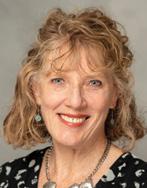
Clinical Associate Professor Dorcas Kunkel, DNP, RN, has clinical and teaching experience at various organizations nationally and internationally, including most recently at Jacksonville University in Florida. She was a clinical assistant professor at the University of Minnesota School of Nursing as part of the Veterans Administration Nurse Academic Partnership. She earned a Doctor of Nursing Practice degree and a master’s degree in public health nursing from the University of Minnesota.
continued on page 62
www.nursing.umn.edu | 61
Clinical Associate
Professor Misty Wilkie, PhD, RN, FAAN, was as an adjunct clinical associate professor at the school, working to create a pathway for Indigenous nursing students to obtain a DNP or PhD. Previously she was a tenured professor at Bemidji State University. Wilkie earned a PhD in nursing from the University of Minnesota, a master’s degree in nursing from University of North Dakota, a bachelor’s degree in nursing from Bemidji State University and an associate degree in nursing from Hibbing Community College.
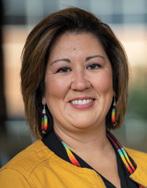
Assistant Professor Alice Lei, PhD, MPH, RN, has scholarship interests in health disparities in minority populations, specifically the health and health behaviors of Chinese American smokers and measurement of perceptions of lung cancer screening. She earned a PhD and master’s degree at the UCLA School of Nursing, a master’s degree in public health from the University of South China, and a bachelor’s degree in nursing from Wuhan University.
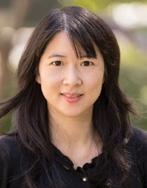
Assistant Professor Christie Martin, PhD, MPH, RN-BC, is a public health researcher and clinician. Her research focuses on promoting healthy behaviors and preventing chronic diseases through the codesign, implementation, and evaluation of accessible, culturally
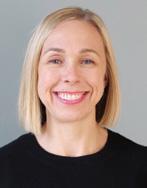
sensitive digital solutions that empower underserved and underrepresented populations. Martin has served as a registered nurse at Abbott Northwestern Hospital and at the Phillips Neighborhood Clinic as a School of Nursing liaison, preceptor and community advisory board member. She earned a PhD in Nursing, master’s degree in nursing
and master’s degree in public health from the University of Minnesota. She earned a bachelor’s degree from Carleton College.
Clinical Assistant
Professor Erin Galegher, DNP, MPH, APRN, CNM, is an experienced fullscope certified nursemidwife. She earned a Doctor of Nursing Practice degree, a master’s degree in public health, master’s degree in nursing at the University of Minnesota.
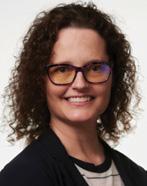
Clinical Assistant
Professor Olof Indridadottir, DNP, CRRN, is a certified rehabilitation nurse and has experience teaching holistic and integrative health assessment, and lab and medical-surgical clinical practicum courses to undergraduate and graduate students.
Indridadottir earned a Doctor of Nursing Practice degree at the University of Minnesota and a bachelor’s degree from the University of Iceland, Reykjavik.
Clinical Instructor
Cassandra Narr, APRN, CNP, MS, is a family nurse practitioner with 18 years of experience in community, pediatric and adolescent and college health care settings.
Previously, Narr served as an associate professor of undergraduate nursing at Winona State University
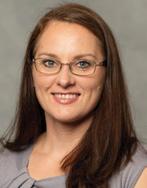
focusing in family and child rearing nursing and community health. Narr earned a master’s degree in nursing at Winona State University and a bachelor’s degree in nursing at the College of St. Benedict.
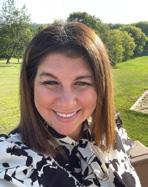
62 | MINNESOTA NURSING
continued from page 61
NEW APPOINTMENTS
Kris Gorman, PhD, joined the school as a project manager for the Mobile Market Study. She earned a bachelor’s degree from Pomona College and PhD in brain and cognitive sciences from the University of Rochester. Previously, she served at the University of Minnesota Center for Educational Innovation.







Kelaine Haas, PhD, joined the school as chief of staff in the Dean’s Office. Haas previously served as the director of integrated education at the Medical School. She earned a PhD in genetics, cellular biology and development from the University of Minnesota and a bachelor’s degree in biology from Wake Forest University.
Dana Hurley, BS, joined the school as the associate for the Adult and Gerontological Health Cooperative. She previously served in the School of Nursing Dean’s Office and the Department of Chemistry. She has a bachelor’s degree in industrial and organizational psychology from Iowa State University.

Courtney Knutson, MA, joined the school as a BSN transfer student success adviser on the School of Nursing’s Rochester campus. Previously she served as a student success coach at the University of Minnesota Rochester and an academic adviser at the College of Liberal Arts. She earned a master’s degree in leadership in student affairs from the University of St. Thomas and a bachelor’s degree at the University of Minnesota Duluth with a focus in management and psychology.
Cynthia Matthias, PhD, joined the school as a research professional for the MEND-R project. She previously served as a graduate research assistant on the MEND-R project. She earned a PhD in organizational leadership and policy development and a master’s degree in evaluation studies from the College of Education and Human Development from the University of Minnesota. She earned a master’s degree in library science from the University of Michigan and a bachelor’s degree in biology from Grinnell College.
Zully Maya, BS, joined the school as a class scheduler and administrative assistant in the Office of Academic Programs. Previously she served as TA/peer-tutor to other computer science students and supported development efforts in the college’s outreach center as a student worker. She earned a bachelor’s degree in computer science from Macalester College.

Karen McCray, BA, joined the school as the PhD and certificate programs coordinator. Previously she served as a coordinator of disability support at DigiPen Institute of Technology in Redmond, Washington. She earned a bachelor’s degree in interior design from Design Institute in San Diego and a bachelor’s degree in history from The University of Iowa.
Sammi Neuens, BS, joined the school as the assistant for the Child and Family Health Cooperative. She earned a bachelor’s degree in business administration from Metropolitan State University. Previously she was a human resources specialist for Alliance Health Care.


Sandy Nikolov, MFT, joined the school as research professional for the Home Food Inventory project. She has previous experience at La Familia Guidance Center, Cigna, Park Nicollet and Hennepin County. She earned a master’s degree in marriage and family therapy from Argosy University and bachelor’s degree in psychology from La Universidad del Salvador Buenos Aires, Argentina.

Elaine Pioske, BS, joins the school as a grant manager in the Office and Nursing Research and Scholarship. She has served as a grants and contracts professional for the Humphrey School of Public Affairs for the past 20 years. She earned a bachelor’s degree in recreation resource management from the College of Natural Resources at the University of Minnesota.
Alexa Squire, BA, joins the school as a Master of Nursing program coordinator. Previously, she served as an academic adviser in the College of Biological Sciences. She also served as an educator in K-12 and adult education at public and charter schools. She earned a bachelor’s degree in English and Spanish from the University of Iowa and a master’s degree in TESOL from Middlebury Institute.
Katherine Wagner, BA, joins the school as the assistant for the Population Health & Systems Cooperative. Previously, she served as an administrative coordinator for M3 Realty. She earned a bachelor’s degree in English from the College of Saint Benedict.
www.nursing.umn.edu | 63
Shaffer named a Living Legend
Franklin Shaffer, EdD, RN, FAAN, FFNMRCSI, president and chief executive officer of CGFNS International, Inc. and University of Minnesota School of Nursing Dean’s National Board of Visitors member, was named a Living Legend. It is the highest designation awarded by the American Academy of Nursing.
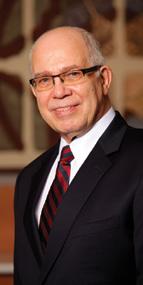
Shaffer has made global efforts to transform the nursing workforce through his leadership. CGFNS, formerly known as the Commission on Graduates of Foreign Nursing Schools, is the world’s leading standards-setting and credentials evaluation organization for nursing and allied health professions. “Every step of Frank Shaffer’s career has been one of bravery, courage, innovation and impact,” says Dean Connie White Delaney, PhD, RN, FAAN, FACMI, FNAP. “Frank has had expansive national and international impact from leading acceptance of men in nursing to unwaveringly advocating for inclusivity, diversity and equity, and leading innovation to ensure a quality and safe nursing workforce. I specifically celebrate Frank’s leadership as president of FNINR, his executive expansion of CGFNS, and his commitment and contributions to our School’s Dean’s National Board of Visitors.”
With the naming of Shaffer as a Living Legend, there are now two Living Legends serving on the Dean’s National Board of Visitors. Brig. Gen. (ret.) Clara Adams-Ender was named a Living Legend in 2013.

New Pediatric Acute Care Nurse Practitioner specialty launched

The University of Minnesota School of Nursing announced a new academic offering, the pediatric nurse practitioner-acute care (PNPAC) specialty. Individuals who hold an advanced practice certification as a pediatric nurse practitioner-primary care and a Doctor of Nursing Practice (DNP) degree can apply to begin the program in June of 2023. The post graduate certificate specialty can be completed in three semesters. There are also options to obtain the PNP-AC post-graduate certificate for individuals without a DNP degree. For more information, contact gophernursing@umn.edu.
Four faculty promotions
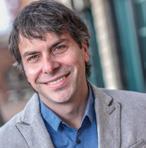
The University of Minnesota Board of Regents approved the promotions of four faculty in the School of Nursing. Sarah Hoffman, PhD, MPH, RN, Martin Michalowski, PhD, FAMIA, and Lisiane Pruinelli, PhD, RN, FAMIA, were promoted to associate professor with tenure. Barbara Peterson, PhD, APRN, PMHCNS-BC, FNAP, was promoted to clinical professor.

64 | MINNESOTA NURSING BRIEFLY
Sarah Hoffman
Martin Michalowski
Lisiane Pruinelli
Barbara Peterson
School of Nursing Foundation grants awarded to faculty, students
The Office of Nursing Research and Scholarship announced the award of School of Nursing Foundation grants to three faculty and six students.
Faculty projects include:
• Examining Consumer Use and Knowledge of Data Sharing Practices within Mobile Health Applications (Assistant Professor Robin Austin, PhD, DNP, DC, RNBC, FAMIA, FNAP)
• Protect Against Heart Attack & Stroke: Know Your Numbers to Control Your Risk! (Associate Professor Erica Schorr, PhD, RN, FAHA)
• Preparing Heart and MindTM: Human Milk Feeding: A Small Feasibility Study of an eHealth Care Program for Spanish Speaking Mothers/Birthing Parents of Infants Prenatally Diagnosed with Complex Congenital Heart Disease (Associate Professor Anne McKechnie, PhD, RN)
Student awards include:
• Skin Deep: Stage 1 Pressure Injury Identification in Patients with Darkly Pigmented Skin. A Quality Improvement Project to Address Health Disparities Based on Skin Color (DNP student Annamaria Cioffi)
• The Experience of Gender Dysphoria in Transgender Young Adults (PhD student Ann Seppelt)
• The Relationships between Abnormal Biomarkers, Motor Symptoms, and Sleep Disorders in Older Adults with Alzheimer’s Disease (PhD student Bella Xiong)
• Transgender Patient Simulation for Pre-Licensure Nursing Students: A Pilot Project (DNP student Mollie Ness)
• Participatory design of vital sign visualizations in a patient dashboard for in-hospital nurses (PhD student Suhyun Park)
• Sustaining Stroke Prevention Education through Community Sharing Forums: A Novel Approach to Dissemination (DNP students Zach Taylor and Emily Gorzycki)
School receives 7th consecutive Health Professions Higher Education Excellence in Diversity Award
For the seventh consecutive year, the University of Minnesota School of Nursing received the Health Professions Higher Education Excellence in Diversity (HEED) Award from INSIGHT Into Diversity Magazine. The school was one of only 16 nursing schools to receive the HEED Award, which honors U.S. nursing, public health, medical, dental, pharmacy, osteopathic, veterinary, and other health schools and centers that demonstrate an outstanding commitment to diversity and inclusion.
Top Colleges for Diversit y 2022
“We are honored to be recognized by INSIGHT Into Diversity Magazine through receiving this award and are energized to continue this important work,” says Barb Peterson, PhD, PMHCNS-BC, APRN, FNAP, director of Inclusivity, Diversity and Equity. “The School of Nursing is creating and sustaining a school environment that prioritizes inclusion, diversity and equity in every facet of the school."
Recently, a number of collaborative efforts between IDE leaders and the Faculty Search Committee, including implicit bias workshops, faculty listening sessions and questions related to equity and inclusion in faculty interview sets the stage for all faculty to consider ways they can further the work of IDE. In the past two years, the number of black, Indigenous and people of color (BIPOC) faculty joining the school grew from 13% to more than 25%.
Additionally, the school’s partnerships with St. Cloud State University, Bemidji State University and St. Paul College created a pathway for underrepresented students to enter the nursing profession, and faculty were hired to specifically support the success of American Indian students.
The school’s efforts to recruit and retain diverse students in the Doctor of Nursing Practice program resulted in an increased BIPOC enrollment from 6% in 2015 to nearly 30% in 2021. Last year the number of BIPOC graduates from the DNP program increased to 23%, showing retention.
Student surveys show an increase in their favorable sense of belonging with more than 80% of students reported feeling a sense of belonging.
Meanwhile, the most recent Employment and Engagement survey showed that 91% of faculty and staff believe the school has a commitment to diversity and inclusion.
The School of Nursing will be featured along with the 64 other recipients of the 2022 HEED Award in the December issue of INSIGHT Into Diversity magazine.
www.nursing.umn.edu | 65
Health Pr ofessions ®
BRIEFLY (CONTINUED)
Kroh named director of the Integrative Health & Wellbeing Coaching Program
Cherie Kroh, EdD, FACSM, NBC-HWC, EP-C, PAPHS, CHWC, EIM Level II, joined the Earl E. Bakken Center for Spirituality & Healing as director of the Integrative Health & Wellbeing Coaching Program.
Kroh earned an EdD in higher education administration at St. Cloud State University, where her dissertation focused on intercultural competence. She holds a master’s degree in exercise and sports science from the University of Utah and a bachelor’s degree in physical education from Minnesota State University – Moorhead. She completed health coaching training through the Mayo Clinic and WellCoaches and is National Board for Health and Wellness Coaching (NBHWC) certified.
Previously, Kroh was employed at Western Governors University Academy, where she has held various roles as a manager of success coaching, academic programs, and the design and development team. Prior to this, she served as an associate professor in the PhD of health science, health promotion, and wellness concentration at Rocky Mountain University of Health Professions. Kroh has also served as a behavioral health specialist and coach at CIGNA Corp. and as an academic coordinator at the Mayo Clinic Health Systems. She is the owner of Wellness Coaching Elevated.
Outstanding preceptors recognized at ceremony
The school recognized the 2021-2022 outstanding preceptors at a ceremony in June. Those interested in working with graduate nursing students as a preceptor can learn more at www.nursing.umn.edu/outreach/ clinical-preceptors.
Laura Kitch from Essentia Health, Duluth was honored for being an adult health/gerontological clinical nurse specialist preceptor.
David Macomber from M Health Fairview was honored for being an adult health/gerontological primary care nurse practitioner preceptor.
Cori Benson from Allina Highland Park was honored for being a family nurse practitioner preceptor.
April Prunty from the VA was honored for being a health innovation and leadership preceptor.
Wanda Baker from Cincinnati Children's Hospital was honored for being an integrative health and healing preceptor.
Dan Levie from Regions Hospital was honored for being a nurse anesthesia preceptor.
Amy Ntoburi from Olmsted Medical Center was honored for being a nurse-midwifery preceptor.
Piper Ranallo from M Health Fairview was honored for being a nursing informatics preceptor.
Mary Sachs from Children's Hospital St. Paul was honored for being a pediatric nurse practitioner preceptor.
Tamara Tew from Aris Clinic was honored for being a psychiatric/mental health nurse practitioner preceptor.
Mark Elias from Mercy Health Care Center (Allina) was honored for being a Women's Health/Gender-Related Nurse Practitioner preceptor.
66 | MINNESOTA NURSING
CENTER DIRECTORS:
Christine Mueller, PhD, RN, FGSA, FAAN
Siobhan McMahon, PhD, MPH, GNP-BC CENTER FOR AGING SCIENCE AND CARE INNOVATION
Leading community-based, clinical research
One of the goals of the Center for Aging Science and Care Innovation (CASCI) is to lead community-based and clinical research that will benefit diverse aging adults and their caregivers' health, independence, and wellbeing. This column is dedicated to briefly highlighting some of our members’ recent research publications with a focus on how they contribute to our research goal, accompanied with information about how to access and read their research.
Nurse scientists, also CASCI members, have recently published results from observational and experimental research projects they led that are community or clinically based. Although their individual projects address distinct phenomena, problems, and possible solutions, some unifying themes exist. For example, all their work aims to improve the health, function, and wellbeing of older people living with chronic conditions and symptoms, such as peripheral artery disease and post-stoke symptoms (e.g., pain, spasticity, fatigue); or chronic risk factors such as those associated with cardiovascular disease and injurious falls. Their research questions are motivated by the state of the practice and science related to their phenomena, problems and solutions of interest. Their answers provide valuable new information to nurses in practice and research.
Following are key takeaways from their research:
• Try using a symptom-cluster lens when assessing people who are recovering from a stroke 1
– Nurses in practice and research should consider assessing the poststroke symptoms of pain, spasticity, and fatigue together, as a cluster, rather than as individual symptoms with different causes and treatments.
• African American men help peers to reduce cardiovascular risks using evidence-based strategies in a community-based, small group intervention 2
– Future research can determine this intervention’s effectiveness and strategies for its implementation and dissemination.
• Deeper engagement (e.g., partnerships) is needed with older people who have fall risk factors to help them create and implement person-centered fall prevention plans 3
– Interdisciplinary team scientists need to identify the types and dosages of engagement and health behavior change strategies to help nurses develop strong partnerships with older people with fall risk factors.
• Total body recumbent stepping is a promising alternative to treadmill walking for improving the function, symptoms, and quality of life among people with peripheral artery disease 4
– Future research can confirm the findings of this pilot study and determine strategies for implementing into practice.
• Older people with cardiovascular risk factors should be encouraged to take breaks from sedentary behavior, but more evidence is needed to understand specific benefits 5
– Nurse scientists need to investigate the short-term and long-term effects of breaks in sedentary behavior among older people with cardiovascular risks, such as Type 2 diabetes. This evidence will help practicing nurses and older people understand the types of breaks most helpful and their specific effects on vascular health.
These takeaways represent only a small aspect of each project. References are below to learn more. Each publication details the premise of the research aims and questions, methods used, results with tables and figures, rich discussions about results compared to prior research, what results might mean, and more implications for practice and research.
1. Bhimani, R., Chappuis, D., Mathiason, M. A., & Anderson, L. C. (2022). Spasticity, Pain, and Fatigue: Are They Associated With Functional Outcomes in People With Stroke? Rehabilitation Nursing Journal, 47(2), 60-71
2. Lee, S., Hadidi, N. N., Lindgren, B. R., Kelley, R., & Lindquist, R. (2022). Peer Group Support Intervention to Reduce Cardiovascular Disease Risk for African American Men According to Life's Simple 7 in Faith-Based Communities. Research and Theory for Nursing Practice.
3. McMahon, S. K., Greene, E. J., Latham, N., Peduzzi, P., Gill, T. M., Bhasin, S., & Reuben, D. B. (2022). Engagement of older adults in STRIDE's multifactorial fall injury prevention intervention. Journal of the American Geriatrics Society.
4. Salisbury, D. L., Swanson, K., Brown, R. J., & Treat-Jacobson, D. (2022). Total body recumbent stepping vs treadmill walking in supervised exercise therapy: A pilot study. Vascular Medicine, 27(2), 150-157.
5. Whipple, M. O., Masters, K. S., Huebschmann, A. G., Scalzo, R. L., Reusch, J. E., Bergouignan, A., & Regensteiner, J. G. (2021). Acute effects of sedentary breaks on vascular health in adults at risk for type 2 diabetes: A systematic review. Vascular Medicine, 26(4), 448-458.
www.nursing.umn.edu | 67
CENTER DIRECTORS:
Robin Austin, PhD, DNP, DC, RN-BC, FAMIA, FNAP
Connie Delaney, PhD, RN, FACMI, FAAN, FNAP
Martin Michalowski, PhD, FAMIA
Lisiane Pruinelli, PhD, RN, FAMIA
CENTER FOR NURSING INFORMATICS
At the leading edge of nurses’ involvement
Center for Nursing Informatics faculty are at the leading edge of nurses' involvement in several national and international initiatives. This year, the 10th annual Nursing Knowledge Big Data Science Conference held June 8-10, 2022, focused on National Patient Outcome Initiatives at the Intersection of Nursing, Informatics, and Big Data
Clinical Associate Professor Priya Rajamani, PhD, MPH, MBBS, FAMIA, and Assistant Professor Robin Austin, PhD, DNP, DC, RN-BC, FAMIA, FNAP, received a federal Office of the National Coordinator training grant aimed to advance health equity by creating sustainable pathways to careers in public health informatics and technology for underrepresented students, and for individuals already in the public health workforce. The TRaining in Informatics for Underrepresented Minorities in Public Health (TRIUMPH) Consortium is a unique partnership between the School of Nursing and the School of Public Health at the University of Minnesota and Georgia Southern University, and will also include an academic partner with HBCU designation.
Associate Professors Martin Michalowski PhD, FAMIA, and Lisiane Pruinelli, PhD, RN, FAMIA, are leading efforts in the field of nursing and artificial intelligence (AI). They served on the organizing committee for the first of its kind, international workshop titled Artificial Intelligence in Nursing: Advances, Methods and Path Forward held in Nova Scotia, Canada. The workshop was organized by the international think-tank Nursing and Artificial Intelligence Leadership Collaborative, of which Pruinelli and Michalowski are founding members.
Further, the School of Nursing’s forward-thinking leadership in driving innovation across teaching, scholarship, and service resulted in the creation of the Center for Artificial Intelligence Research in Heath (HEALTHCAIR). HEALTHCAIR, a major School of Nursing initiative in collaboration with the College of Pharmacy, co-led by Michalowski and Serguei Pakhomov, PhD, provides a collaborative environment to fully realize AI’s potential in health care through educational and scholarly advancement in AI.
Center leadership changes named Austin as director and Connie White Delaney, PhD, RN, FACMI, FAAN, FNAP, Michalowski, and Pruinelli as co-directors. If you would like more information about these initiatives please contact center faculty at quis0026@umn.edu.
CENTER DIRECTOR: Renee Sieving, PhD, RN, FAAN, FSAHM CENTER FOR ADOLESCENT NURSING
Promoting and protecting adolescent mental health
The COVID-19 pandemic has dramatically changed the world for young people. Many have missed months or even years of in-person school, graduation ceremonies, sports competitions, and time with friends and relatives. They and their families may have lost access to mental health care, social services, income, food or housing.
For many adolescents, these disruptions have resulted in substantial mental health challenges. Long identified as a major public health concern, these challenges have been exacerbated by the pandemic. In a recent Centers for Disease Control and Prevention survey, more than one in three U.S. high school students experienced mental health struggles during the pandemic. The staggering impact the pandemic had on mental health was the impetus for our 2022 Adolescent Health Summer Institute Promoting & Protecting Adolescent Mental Health.
Held virtually for the third year, and with over 100 youth-serving professionals from 16 states, this year’s institute focused on approaches, tools and resources to support adolescent mental health. Through our virtual platform, we engaged with adolescent health experts who addressed healing justice, optimizing mental health, digital wellbeing, transforming systems and holistic perspectives. We also engaged with young people who shared their perspectives on mental health needs of adolescents living in under-resourced communities as well as ways to engage in and advocate for young people’s digital wellbeing.
“Sound mental health is an essential foundation for adolescent health and development,” says Professor Renee Sieving, PhD, RN, FAAN, FSAHM. “By exploring recent patterns in adolescent mental health using developmental and social-ecological lenses, we provided tools and resources to those working with youth, to help them guide young people in sustaining and reclaiming their mental wellbeing. This is a key moment to support adolescents’ mental health, as well as to change aspects of schools, community organizations, and other institutions that shape their daily lives, so that all young people can thrive.”
68 | MINNESOTA NURSING
Promoting healthy behaviors in Hispanic, Latino/a high schoolers
High schoolers in the United States who selfidentify as Hispanic or Latino/a have the secondhighest rate (38.8%) of overweight/obesity.
Evidence supports culturally sensitive behavioral interventions tailored to subgroups by family country of origin and aimed at promoting healthy behaviors. Unfortunately, Hispanic or Latino/a adolescents are underrepresented in pediatric obesity prevention literature, thus less is known about protective factors against overweight/obesity among these youth.
Center member and Assistant Professor Christie Martin, PhD, MPH, RN-BC, LHIT-HP, recently had her dissertation research Weight
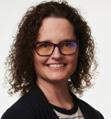
Status Among Minnesota Hispanic or Latino/a Youth: An Exploration of Protective Factors published in the American Journal of Health Promotion. Co-authors included Center Director Jayne Fulkerson, PhD, NAP; Marla Eisenberg, ScD; Barbara McMorris, PhD; Carolyn Porta, PhD; and Renee Sieving, PhD; statistician, Michelle Mathiason, MS; Yazmin Cespedes, MPH; and Sarah Espinoza, PhD.
The purpose of this secondary analysis of a population-based statewide survey—the Minnesota Student Survey—was to determine prevalence rates and identify protective factors (meeting fruit and vegetable recommendations, meeting physical activity recommendations, family caring, and family country/region of origin) associated with having overweight/ obesity in 5,442 Minnesota Hispanic or Latino/a 9th and 11th graders.
Meeting physical activity recommendations was protective against overweight or obesity in males and females. Family caring was protective against overweight/obesity in females only, and family country/region of origin was protective against overweight/obesity in females and males. Family caring was protective against overweight/obesity in females only, and family country/region of origin was protective against overweight/ obesity in females and males.
The research advanced the science of pediatric obesity literature by providing foundational knowledge regarding obesity-related protective factors among Hispanic or Latino/a youth and direction for future intervention development to promote health equity. Findings illustrate a need to explore the protective nature of family caring and family country/ region of origin. Martin plans to continue exploring health behaviors and outcomes among Hispanic or Latino/a populations and expects to codesign culturally sensitive digital tools aimed at empowering underserved and underrepresented individuals, families and communities.
LEARN MORE
Read Weight Status Among Minnesota Hispanic or Latino/a Youth: An Exploration of Protective Factors at z.umn.edu/weightstatus.
CENTER DIRECTOR: Wendy Looman, PhD, APRN, CPNP CENTER FOR CHILDREN WITH SPECIAL HEALTH CARE NEEDS
Celebrating the career of Casey Hooke
The Center for Children with Special Health Care Needs (CSHCN) recently joined the School of Nursing in celebrating the career of long-time center member Casey Hooke, PhD, APRN, PCNS-BC, FAAN. Hooke retired on June 30 after serving as a faculty member in the school from 2011 to 2022. Hooke began her career as a pediatric nurse after earning her Bachelor of Science degree in Nursing at the State University of New York at Binghamton in 1976. She completed her Master of Science in 1981 and her PhD in 2009 from the University of Minnesota School of Nursing. As a CSHCN member, Hooke contributed expertise and mentorship related to the care of children and adolescents with cancer. Hooke's research, practice and teaching focused on promoting the healthy development of these children and adolescents by reducing symptoms that interfere with their health and quality of life. As a member of the pediatric APRN faculty in the school, Hooke provided leadership in the pediatric clinical nurse specialist area of study, supporting future providers to gain skills in caring for children with special health care needs.
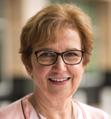
Hooke has been a national leader in the area of pediatric hematology and oncology, as an active member of a national cooperative study group of pediatric cancer clinical trials, as past president of the Association of Pediatric Hematology/Oncology and as assistant editor of the organization’s journal.
Hooke has received numerous awards and recognition for her scientific work and leadership in pediatric cancer nursing, including induction as a fellow in the American Academy of Nursing in 2018 and receiving the Association of Pediatric Hematology/Oncology Nurses Distinguished Researcher Award in 2020. We wish Hooke the very best as she spends time with her family and continues her passion work as one of our faculty emeriti.
www.nursing.umn.edu
| 69
Christie Martin
CENTER DIRECTOR: Jayne Fulkerson, PhD CENTER FOR CHILD AND FAMILY HEALTH PROMOTION RESEARCH
Casey Hooke
REMPHER, BSN ’93, NAMED AN AAN FELLOW
Kenneth Rempher
The American Academy of Nursing (AAN) announced that alum Kenneth Rempher, BSN ’93, was selected to be inducted into the 2022 Class of Fellows. The achievement is considered one of the highest honors in the nursing profession.
Fellows are nurse leaders who are experts in policy, research, administration, practice and academia that champion health and wellness, locally and globally.
CLASS NOTES
Kris Klimisch, BSN ’92, received an Educator of the Year award from the Carthage College Department of Nursing.
Ray Constantine, MS ’99, BSN ’95, celebrated 20 years with Health East/M Health Fairview.
Kuei-Min Chen, PhD ’00, MS ’96, presented the lecture Using Complementary Alternative Therapies to Promote the Health of Older Adults. The lecture was sponsored by the School of Nursing’s Center for Aging Science and Care Innovations.
Maggie Mathison, BSN ’03, published a chapter titled Engaging with Nature for Health Promotion in the Alliance of Nurses for Healthy Environments nursing e-textbook, Environmental Health in Nursing.
Maria Raines, MS ’04, was a recipient of a 2022 TRUST Award. The award celebrates Minnesota women who are transforming the future of the healthcare industry.
Becky Ahlstrom, MS ’07, celebrated five years of her geriatric primary care practice, Integrative Geriatrics.
Rempher served as chief nurse executive at Cone Health in North Carolina and chief nursing officer at the University of Iowa Hospitals and Clinics. Currently he is an adjunct clinical professor at University of North Carolina Greensboro.

An induction ceremony was held at AAN’s annual Health Policy Conference in October in Washington, D.C.
Terryann Clark, PhD ’08, was appointed to the Cure Kids Chair in Youth and Adolescent Mental Health by Cure Kids and the University of Auckland.
Dan Lovinaria, DNP ’08, was named a 2022 Minneapolis/St. Paul Business Journal Healthcare Hero.
Mary Dierich, DNP ’10, MS ’93, BSN ’80, was inducted into the Fellows of the American Association of Nurse Practitioners (AANP). In 2020, Dierich was named the AANP Awardee for Clinical Excellence in Minnesota. Dierich and Dianne Willer-Sly, DNP ’08, were awarded a grant from the AANP History Committee to document the history of nurse practitioners in Minnesota. Dierich also helped develop a group presentation on advocacy for the Gerontological Advanced Practice Nurses Association national conference.
Melissa Gleaves, MS ’10, began a new role as an adjunct clinical instructor with the School of Nursing in addition to her current role at M Health Fairview.
Andrea Leszko, BSN ’11, started a new role as Chief Nurse, Education and Designated Learning Officer at the United States Department of Veteran Affairs.
Samantha Huguelet, DNP ’12, MS ’02, hosts the Pregnancy and Postpartum Support Minnesota Baby Brain podcast.
Maridee Shogren, DNP ’12, was named interim dean of the University of North Dakota College of Nursing & Professional Disciplines.
Rachel Rivard Bach, MN ’13, started a new role as Senior Clinical Specialist at Emerging Therapy Solutions.
Debbie Gregory, DNP ’16, was promoted to principal with a focus on healthcare innovation consulting at Smith Seckman Reid, Inc.
Oriana Beaudet, DNP ’17, conducted an interactive training at the 2022 Texas Nurses Association Annual Meeting. Beaudet was also a keynote speaker at The Clemson University International Nursing Conference for Excellence in Healthcare.
70 | MINNESOTA NURSING ALUMNI NEWS
Grace Brooks, BSN ’18, was featured by Twin Cities news outlets for her dedication in the Pediatric ICU at Children’s Minnesota. Brooks organized a donation drive for her unit’s break room to help colleagues find rest and encouragement amid the COVID-19 pandemic and staffing shortages.
Aracely Duerkop, BSN ’18, has worked as a military Navy nurse for four years. Duerkop also recently graduated with a FNP/MSN from Duke University.
Kent Boyd, MN ’18, is a Planetary Health Alliance Meeting intern with the Planetary Health Alliance.
Sarah Held, DNP ’19, started a new role as chief nursing and quality officer at the Hazelden Betty Ford Foundation.
Meagan Thompson, DNP ’19, MN ’15, started a perinatal addiction program at the University of Iowa.
Travis Moore, DNP ’19, and Erin Doherty, DNP ’20, launched the Common Roots Podcast through their coaching and consulting practice of the same name. The podcast explores nursing leadership.
Blaire Bemel, BSN ’20, published her undergraduate honors thesis A Predictive Model for Developing Long-Term Opioid Use After Neurosurgery and Orthopedic Surgery in the AANA Journal.
Tristan Fin, DNP ’20, began a new role as executive director of clinical systems at The University of New Mexico Hospitals.
Andrew Jensen, BSN ’21, was selected to be part of the 2022 Planetary Health Annual Meeting planning committee.
Tucker Annis, DNP ’21, BSN ’15, began a new role as clinical informaticist lead at UCare.
Marsha Cole, DNP ’21, began a new role as clinical informatics specialist at TeleSpecialists.
Rebecca Brown, PhD ’21, MN ’13, started a new role as nurse scientist at the Minneapolis VA.
Nellie Swanson, DNP ’21, joined the pediatric team at the Essentia HealthDuluth Clinic. Swanson also published Encourage, Assess, Transition (EAT): A Quality Improvement Project Implementing a Direct Breastfeeding Protocol for Preterm Hospitalized Infants in Advances in Neonatal Care.
Amanda Totenberg, DNP ’21, was elected Legislative Chair for the National Association of Pediatric Nurse Practitioners Minnesota.
Gertrude Thomas, DNP ’22, presented a poster presentation this fall at the DNPs of Color Conference.
Ryne Wilson, DNP ’22, was selected to join the Oncology Nursing Society Leadership Development Committee’s 2022 Young Leaders pilot program.
KEEP US UP TO DATE
Have you recently received a promotion, hired for a new position or honored with an award? Keep us up to date and let us know by visiting www.nursing.umn.edu/alumni.
www.nursing.umn.edu | 71
REMEMBERING PATRICIA KANE, MSN ’77
Nursing was her passion, and her connection with the School of Nursing is deeply felt and celebrated. Patricia “Patty” Kane always looked forward to the chance to meet the awardee of the Patricia S Kane Scholarship and hear news about the school. She received her registered nursing degree at St. Barnabas School of Nursing in Minneapolis in 1962, then went on to the University of Minnesota and received her MS in Nursing in 1978. During her career, she worked at St. Barnabas Hospital, at Abbot-Northwestern School of Nursing, and at the State of Minnesota Board of Nursing. Patty was also a Trustee Emerita of the University of Minnesota School of Nursing Foundation and a member of Phi Beta Kappa. The School of Nursing is honored to have had Patricia Kane as an alum and advocate.
REMEMBERING RICHARD KALOW

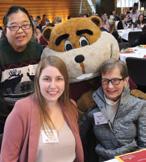
Whether celebrating the recipient of the Eileen Vinnes Kalow Fellowship in Children’s Health, a fund that honors the nursing career of his alumnus wife, partaking in casual conversation with University of Minnesota President Joan Gabel and School of Nursing Dean Connie White Delaney, or sharing a life-well-lived type of story over a gimlet in the backyard, Harry Richard “Dick” Kalow was intent on impacting countless generations of nurse leaders. A skilled plumber and proud Naval Reservist, Dick regularly attended the Dean’s Annual Scholarship Reception, Dean's Circle Dinner, and other School of Nursing events. “Dick’s gregarious nature and his genuine concern for the School and its students was so special,” says Delaney. “We are honored and grateful to be part of his legacy.”
IN REMEMBRANCE
Marjorie K Jamieson, MSN ‘79, was an assistant professor at the School of Nursing, an instructor at the Carlson School of Management, and a Distinguished Alumna of both the School of Nursing and St. Olaf College. She was widely lauded for her role in establishing the Block Nurse Program, transforming care options that encourage a neighborhood-based, home care system that is still used today. This program allows elderly individuals to stay in their own homes by engaging neighbors, under the direction of registered nurses, in their care and has become a highly regarded, dynamic national and international model of care.
Lois Freeberg-Requa, MS ’82, BSN ’70, passed away Sept. 1, 2022. FreebergRequa was a nursing professional and long-time member of the School of Nursing community. She had an extensive career as a nurse, nurse educator and clinical director of Nursing at Mayo Hospital in Rochester. As a nurse educator she focused on teaching skills in a manner that valued the patient’s inherent worth and dignity. While she was a volunteer, she worked
with the Heritage Committee at the School of Nursing to help collect, preserve and promote the history of the School of Nursing and its impact.
Elizabeth A Colloton, BSN ‘83, was a nurse and an instructor of nursing for over 50 years in the United States and in Germany, and recipient of the Excellence in Nursing Education Award from the School of Nursing Alumni Society in 1984. She concluded her career as a public health nurse with the City of Chicago Department of Public Health. Prior to her time in Chicago she served in the United States Navy Reserve, where she attained the rank of Commander. Colloton was a long-time volunteer with and officer of SIDS of Illinois, Inc and an active supporter of Women in Military Service for America.
Amos S Deinard, passed away March 9, 2022. Deinard was a faculty member in the University of Minnesota’s Department of Pediatrics, past-director of the Community-University Health Care Center in Minneapolis, founder of the Minnesota Oral Health Project, and former School
of Nursing Foundation Board member. He received his Bachelor of Arts in Chemistry from Harvard University in 1957 and after a single year of law school at the University of Minnesota (1957-58), he found his calling in medicine, graduating from the University of Minnesota Medical School in 1962. He obtained his MPH degree in Maternal and Child Health from the University of Minnesota School of Public Health in 1985.
Gloria J Tew passed away on Jan. 31, 2022. She was a sculptor and friend of the School of Nursing. Her many notable works include a 15-ft. bronze wall relief Forever Caring, a commemoration of nursing in the Gonda Building at the Mayo Clinic and a stainless steel sculpture Enlightened Touch at the University of Minnesota School of Nursing. She presented a marble sculpture titled Caring to King Carl Gustav and Queen Silvia of Sweden and has an 8-ft. bronze sculpture of Caring in Vaxjo, Sweden. She is featured in Patricia Donahue’s book Nursing, The Finest Art.
72 | MINNESOTA NURSING
IN MEMORY
Dolores A Smith, BSN ‘38
Bertha A Johnston, BSN ‘39
Audrey A Reinhold, BSN ‘39
Alice M Drummond, BSN ‘40
Mattie M Widen, BSN ‘42
Elizabeth H Spain, BSN ‘45
Virginia Heinzmann, BSN ‘45
Elizabeth H Blevins, BSN ‘46
Genevieve A Laskowski, BSN ‘46
Dorothy M Dickey, BSN ‘47
Karen S Johnson, BSN ‘47
Elizabeth S McLaughlin, BSN ‘47
Rose M Price, BSN ‘47
Mary M McLaughlin, BSN ‘48
Lila M Fee, BSN ‘48
Marilynn N Amann, BSN ‘49
Mary Lou Shumway, BSN ‘50
Beverly A Wood, BSN '51
Mary E Lensink, BSN ‘52
Elaine A Mason, BSN ‘52
Dorothy A Lym, BSN ‘52
Joan C McLean, BSN ‘52
R C Stevens, BSN ‘52
Theresa M Lilley, BSN ‘53
Dorothy Bradford, BSN ‘53
Mary L Zordel, BSN ‘54
Helen M Sullivan, BSNE ‘54
Marjorie R Hoagland, BSN ‘55
Kathleen M Luthens, BSN ‘56
Lyla L Niederbaumer, BSN ‘56
Eleanor C Beethe, BSN ‘56
Susan S Walker, BSN ‘56
Ruth Guida, BSNE ‘56
Betty J Moyer, BSN ‘56
Muriel M Lehman, BSN ‘57
Janet B Stende, BSN ‘57
Donna E Wraspir, BSN ‘57
Pat Woody, BSN ‘57
Sharon A Stickel, BSN ‘58
Naomi Tanikawa, BSN ‘58
Marjorie A Jacobsen, BSN ‘59
Kathleen A Meuwissen, BSN ‘59
Mary E Tananis, MSN ‘59
Ms Dorothy J Dobratz, BSNE ‘60
Sandra K Kennaugh, BSN ‘61
Jessie M Richards, BSN ‘61
Margaret J Nordlie, BSN ‘61
Arlis H Christenson, BSN ‘62
Dorothy I Sorbo, BSN ‘63
Margaret G Fogelson, BSN ‘63
Nicole Virginny Morton, BSN ‘63
Myrna J Goodman, BSN ‘64
Dorothy M Bennett, BSN ‘64
Patricia L Jenkins, BSN ‘65
Shirley A Peterson, PN ‘66
Carole L Hodges, BSN ‘69
Frances C Rowan, MSN ‘69
Gary L Horton, BSN ‘74
Glenn R Horton Jr, BSN ‘75
Kathryn M Komar, BSN ‘78
Virginia L Norman, MSN ‘80
Mary Pynn, MSN ‘80
Jean K Arnt, BSNA ‘81
Mary B Eichmiller, MSN ‘81
Margaret M Sherman, MSN ‘83
Jeannine J Beasley, BSNA ‘84
Michael G Johnston, BSNA ‘84
Lynn A Lundgren, MSN ‘85
Patricia A Pousard, BSN ‘88
Barbara H Adrian, BSNA ‘89
Jeanette M Olson, BSN ‘91
Brenda P Bublitz, MSN ‘92
Daniel P Kenward, BSN ‘97
Cynthia W Baird, MSN ‘97
Dana Feld, MSN ‘08
www.nursing.umn.edu
| 73
FINISH
School of Nursing freshmen participate in New Student Convocation on Sept. 1. The ceremony is the University of Minnesota’s official welcome to the Class of 2026.


Sophomores in the Bachelor of Science in Nursing Program and first-year Master of Nursing students celebrated their entry into the nursing profession with Goldy at a ceremony in September.
The school celebrated the graduation of 133 Bachelor of Science in Nursing students, 128 Doctor of Nursing Practice students and five PhD in Nursing students at a commencement ceremony May 13 at Northrop.

SCHOOL NEWS PHOTO
74 | MINNESOTA NURSING
Visiting professor Kuei-Min Chen, PhD ‘00, MS ‘96, presented Using Complementary Alternative Therapies to Promote the Health of Older Adults at a lecture sponsored by the Center for Aging Science and Care Innovation in September.

Carolyn Schroeder, BSNE '55, Joanne Disch, PhD, RN, FAAN, and Sue Forstrom, MS '79, BSN '65, at the Dean’s Dinner in September.

Judy Pechacek, DNP, RN, CENP, assistant dean, Doctor of Nursing Practice (DNP) program, addresses students at the DNP Enhancement and Enrichment Programming (DEEP) Day Sept. 15. The focus was the evidence-based value of story-telling in health care.

www.nursing.umn.edu | 75
PHOTO FINISH www.nursing.umn.edu |
5-140 Weaver Densford Hall 308 Harvard Street S.E. Minneapolis, MN 55455 www.nursing.umn.edu

OF NURSING PRACTICE
Nonprofit Org. U.S. Postage PAID Twin Cities, MN Permit No. 90155
#7DOCTOR
PROGRAM U.S. News and World Report



















 by Steve Rudolph
by Steve Rudolph



 Sheriff Deputy Colby Palmersheim and DNP student Nicole Hoffman during her ride along in Otter Tail County.
Sheriff Deputy Colby Palmersheim and DNP student Nicole Hoffman during her ride along in Otter Tail County.

 by Susan Maas
by Susan Maas

 by Kim Kiser
by Kim Kiser







































































